On July 20, 1969, a human walked on the Moon for the first time.
Relive the full journey to and from the the Moon with the timeline below.
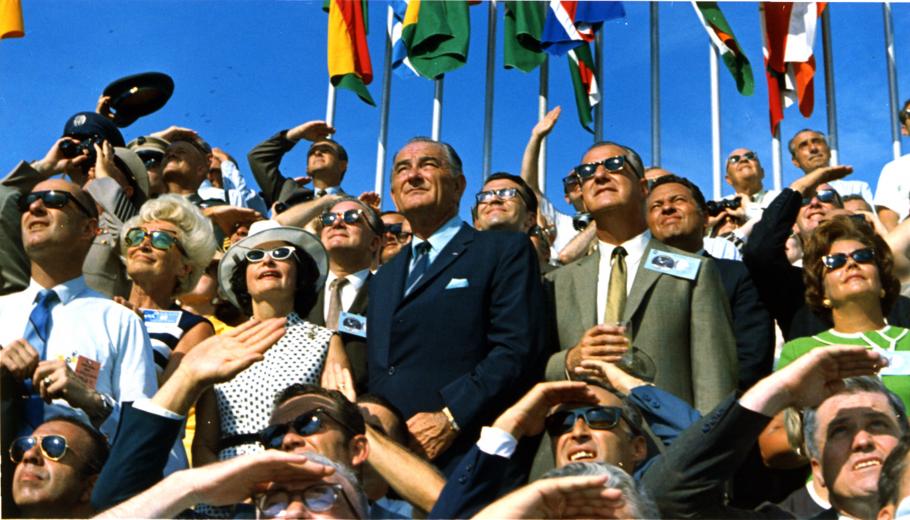
July 16, 1969 13:32:00 UTC (Universal Coordinated Time) 9:32 am ET (Eastern Time)
Liftoff! The Apollo 11 Spacecraft launched from Cape Kennedy.
Over a million spectators, including Vice President Spiro Agnew and former President Lyndon Johnson, have come to watch the lift off.

Traveling to the Moon
From launch to landing, Armstrong, Aldrin, and Collins were on a three day journey to the Moon. One thing that was not widely publicized during the Apollo program was that the astronauts carried music with them into space. According to most accounts, the astronauts of Gemini and Apollo listened mainly to adult contemporary and country music.
Neil Armstrong’s musical tastes were a bit more complex than his colleagues. He chose to bring something spacey onboard his space capsule: Theremin music.
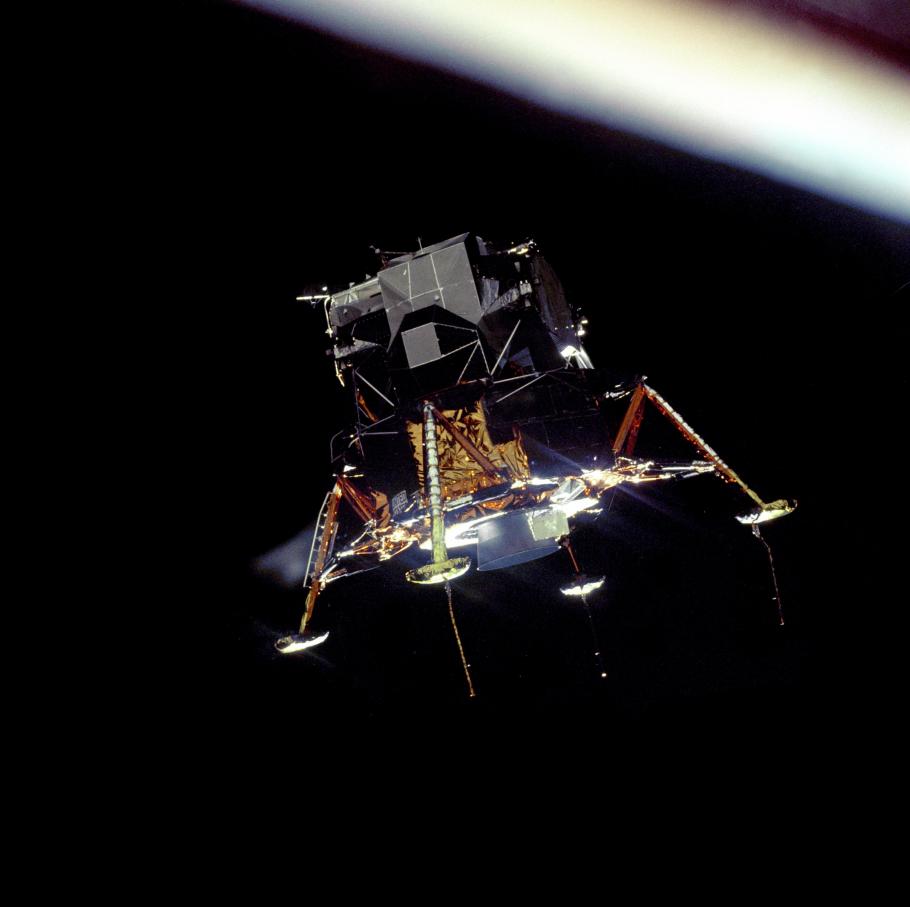
July 20, 1969 17:44 UTC 1:44 pm ET
The lunar module with Armstrong and Aldrin aboard was undocked from the command module. At 101:36 GET, the descent to the surface of the Moon began.
Michael Collins stayed aboard the Command Module Columbia , serving as a communications link and photographing the lunar surface.
More about Collins's journey to the far side of the Moon
July 20, 1969 20:17 UTC 4:17 pm ET
The Eagle Has Landed!
The lunar module touched down on the surface on the Moon.
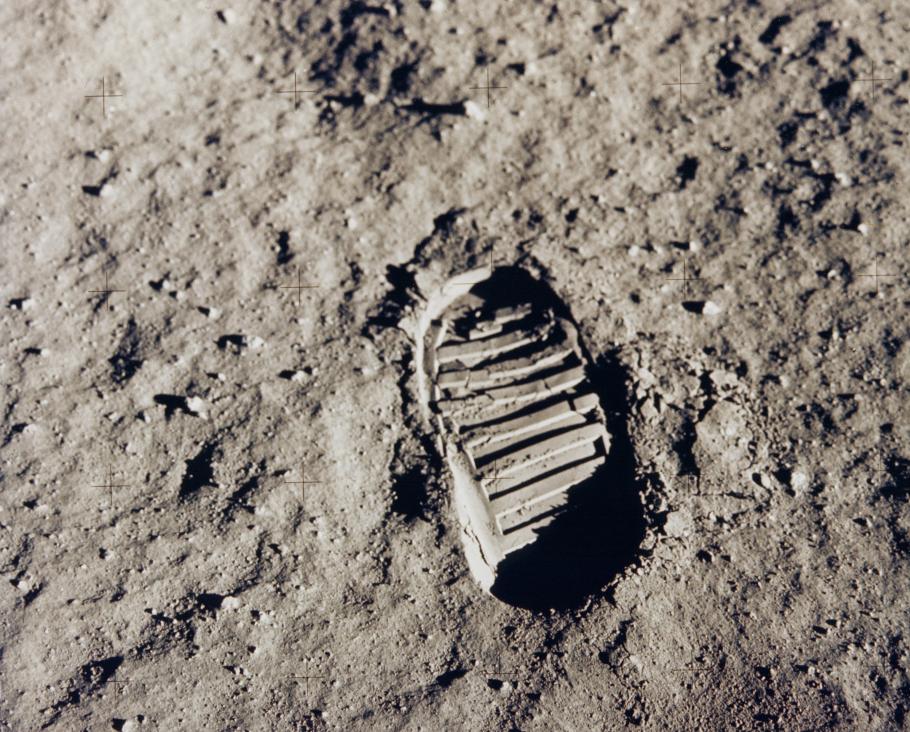
July 21, 1969 2:51 UTC July 20, 1969 10:51 pm ET
Neil Armstrong begins his descent from the lunar module and takes humankind’s first steps on the Moon, followed by Buzz Aldrin.
July 20, 1969 2:56 UTC July 21, 1969 10:56 pm ET
That's one small step for man, one giant leap for mankind.
On the Moon, the astronauts carried out a planned series of experiments. Approximately two hours and fifteen minutes later, the astronauts prepared to reenter the lunar module.
About the Experiments
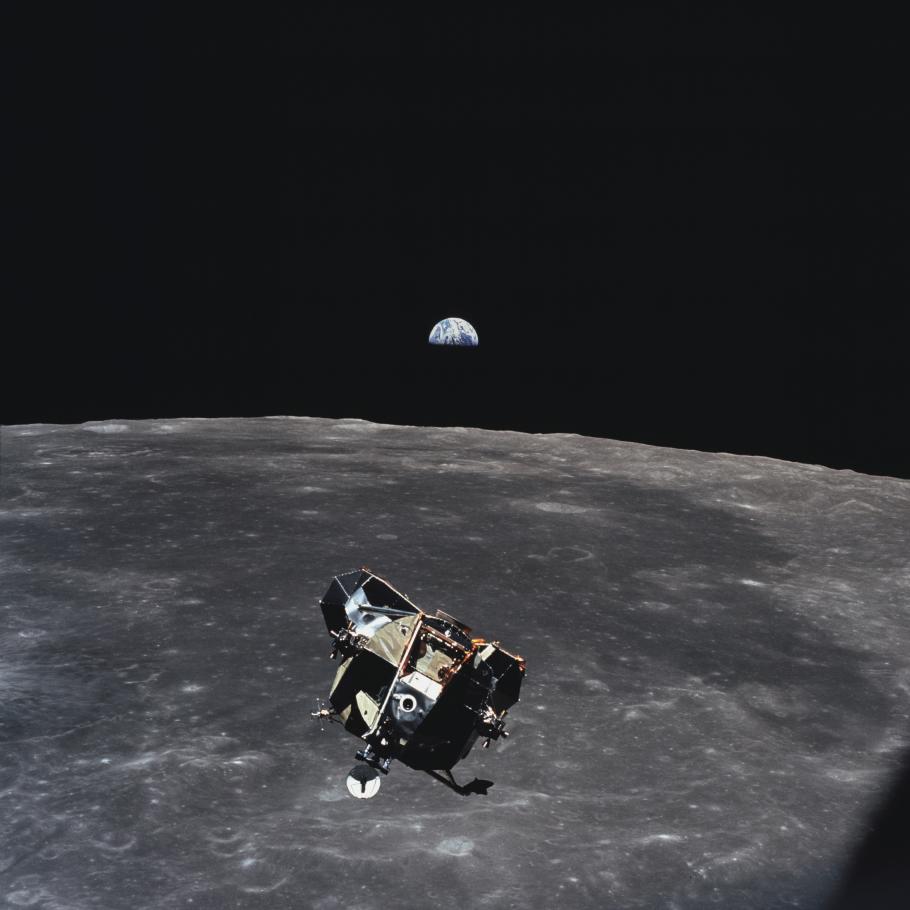
July 21, 1969 17:54 UTC 1:54 pm ET
The ascent from the lunar surface began. At 21:35 UTC (5:35 pm ET) lunar module would rendezvous with the command and service modules, where Michael Collins would welcome back Aldrin and Armstrong. At 23:41 UTC (9:41 pm ET) Lunar Module Eagle was jettisoned into lunar orbit.
What We Left Behind
July 22, 1969 4:55 UTC 11:55 pm ET
Apollo 11 left lunar orbit to return to Earth.
July 24, 1969 4:51 UTC 12:51 pm ET
Splashdown!
The astronauts returned to Earth. In case the Moon had any traces of biological pathogens, the astronauts had to stay in quarantine for 21 days.
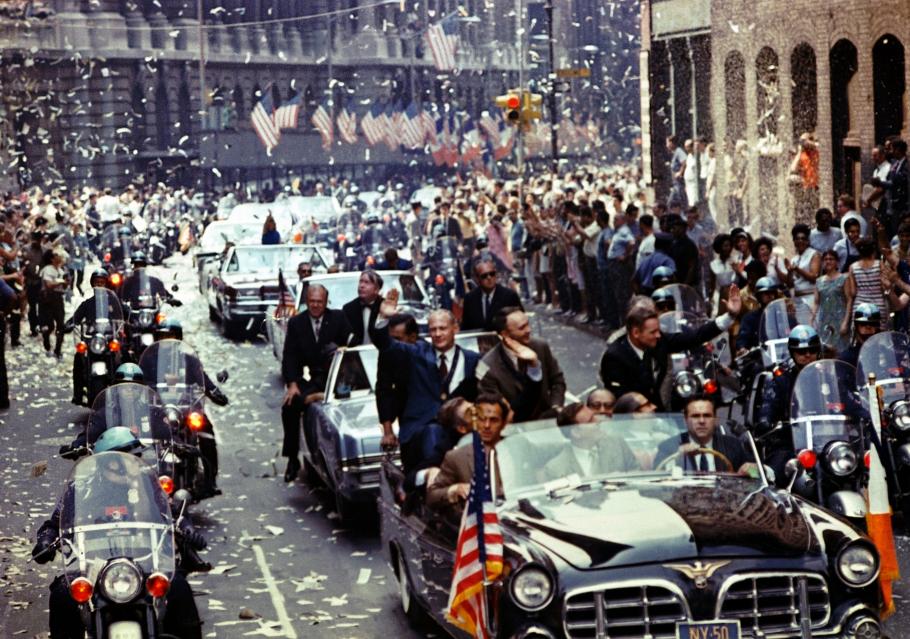
After 21 Days in Quarantine
The United States celebrated the returning heroes in the time-honored tradition reserved for such occasions: parades. The astronauts were lauded at parades across the nation, from New York, to Chicago, to their hometowns, and eventually partook in a world tour.
More About Welcoming the Astronauts Home
The Family That Knocked on Neil Armstrong's Door
- Get Involved
- Host an Event
Thank you. You have successfully signed up for our newsletter.
Error message, sorry, there was a problem. please ensure your details are valid and try again..
- Free Timed-Entry Passes Required
- Terms of Use

Journey to the Moon
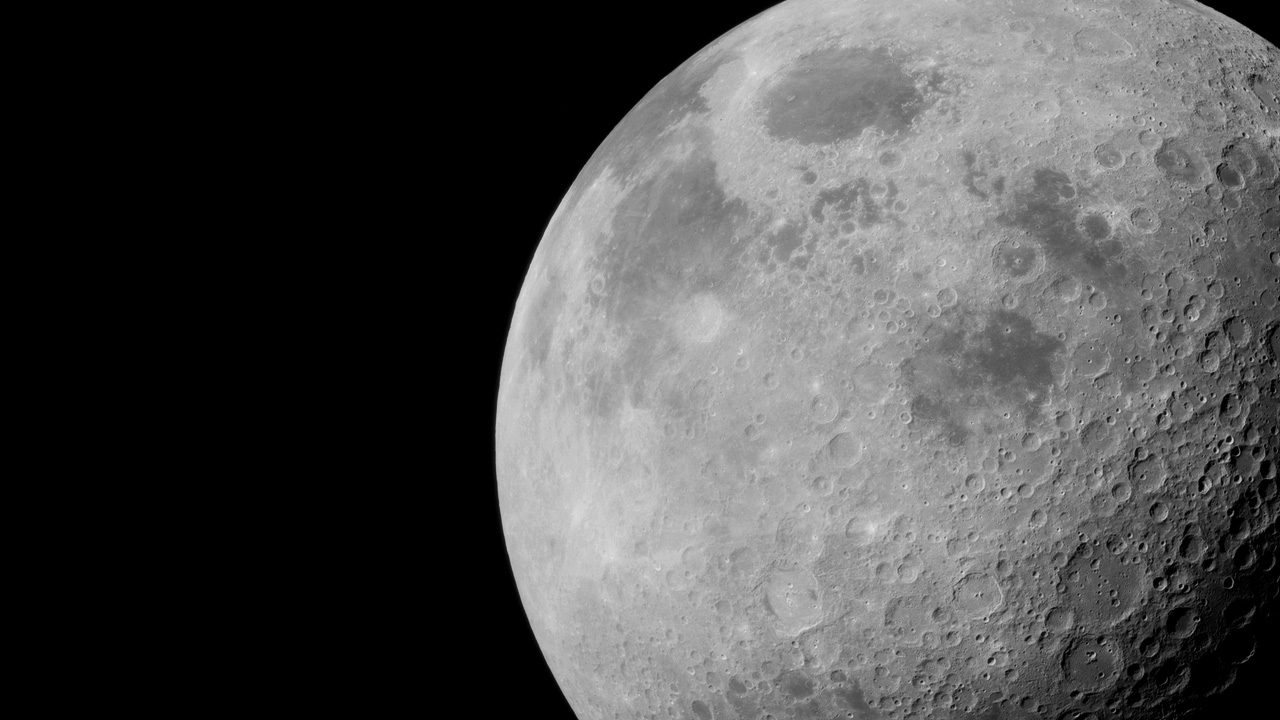
The approximately 250,000-mile journey from Earth to the moon took Apollo astronauts about three days.
The closest look we’ve had at the moon came from the launch of NASA’s Apollo program in the 1960s. Between 1967 and 1972, a series of missions landed the first men on the moon. Equipped with handheld cameras, Apollo astronauts documented their journey, capturing photos of the moon and its rocky terrain through surveys conducted from lunar orbit and on the ground. The collection of moon exploration photos includes up-close views of impact craters, mountain ranges, volcanic channels and maria—dark regions believed to have been formed from molten rock. The images are part of a massive archive of more than 14,000 photos taken by Apollo astronauts.

Sep 7, 2023
jpg (222.47 KB)
- The Devastation of Hurricane Katrina: A Look Back at One of the Deadliest Natural Disasters in World History
- Understanding Tsunami in Japan
- Exploring the World of Gods and Goddesses
- The Cold War's Impact on the Space Race: A Comprehensive Overview
- Knights and Chivalry
- Code of Conduct
- Armor and Weapons
- Medieval Life
- Health and Medicine
- Holidays and Celebrations
- Serfs and Peasants
- Kings and Lords
- City-States
- Gods and Goddesses
- Julius Caesar
- Industrial Revolution
- Impact on Society
- World War II
- Allied Powers
- Atomic Bomb
- World War I
- Treaty of Versailles
- Major Battles
- Leaders and Rulers
- Alexander the Great
- Queen Elizabeth I
- Napoleon Bonaparte
- Activists and Reformers
- Nelson Mandela
- Susan B. Anthony
- Mahatma Gandhi
- Scientists and Inventors
- Thomas Edison
- Marie Curie
- Albert Einstein
- Fall of the Berlin Wall
- Cuban Missile Crisis
- Civil Rights Movement
- Martin Luther King Jr.
- Segregation
- Climate Change
- Renewable Energy
- Greenhouse Effect
- Impact on Environment
- African Cultures
- Egyptian Culture
- Nigerian Culture
- Asian Cultures
- Japanese Culture
- Indian Culture
- Chinese Culture
- Latin American Cultures
- Aztec Civilization
- Mayan Civilization
- Inca Civilization
- Natural Disasters
- Tsunami in Japan
- Hurricane Katrina
- Pompeii Eruption
- Important Events
- Signing of the Declaration of Independence
- Discovery of Penicillin
- Moon Landing
- Cultural Achievements
- Renaissance Art
- Ancient Chinese Inventions
- Assessment Tools
- Projects and Presentations
- Writing Assignments
- Quizzes and Tests
- Teaching Methods
- Interactive Learning
- Primary Sources
- Role-playing
- Educational Resources
- Online Databases
- Educational Games
- Museums and Exhibits
- Photographs and Artifacts
- Government Documents
- Diaries and Letters
- Online Sources
- Websites and Blogs
- Digital Archives
- Books and Literature
- Historical Fiction
- Biographies
- A Journey to the Moon: Exploring the History of the Moon Landing
- Historical Facts
The Moon landing is a pivotal moment in human history, marking the first time that mankind set foot on another celestial body. It was a monumental achievement that captured the world's imagination and sparked a new era of space exploration .On July 20, 1969, NASA's Apollo 11 mission successfully landed astronauts Neil Armstrong and Buzz Aldrin on the Moon's surface, while Michael Collins orbited above. This incredible feat was the culmination of years of research, planning, and technological advancements. In this article, we will take a journey back in time to explore the history of the Moon landing and delve into the significance of this event in our collective consciousness. We will also examine the various theories and controversies surrounding this historic event, shedding light on the incredible achievements and challenges faced by the astronauts and scientists involved. This article is part of our Silo on Historical Facts and Important Events, as we believe that understanding our past is crucial in shaping our future.
So buckle up and get ready for an out-of-this-world journey through one of the most iconic moments in human history - the Moon landing. To fully understand the significance of the Moon Landing , we must first explore its historical context. The Space Race between the United States and Soviet Union was in full swing during the 1960s, with both nations vying for dominance in space technology. This competition ultimately led to President John F. Kennedy's bold declaration in 1961 to land a man on the moon before the end of the decade.
From there, we will delve into the details of the Apollo 11 mission, from its launch to its successful return to Earth. Learn about the challenges and triumphs faced by astronauts Neil Armstrong , Buzz Aldrin , and Michael Collins as they embarked on this historic journey. We will also discuss the groundbreaking technology and scientific advancements that made the Moon Landing possible. No discussion of the Moon Landing would be complete without exploring its impact on global culture .
The Early Days of Space Exploration
The apollo 11 mission: from launch to landing, the impact of the moon landing on global culture, inspiring future generations: the legacy of the moon landing.
In this section, we will delve into the details of the Apollo 11 mission, from its launch to its successful landing on the lunar surface. The spacecraft used for the Apollo 11 mission was named Apollo 11, and it consisted of three main components: the Command Module, the Service Module, and the Lunar Module. The Command Module housed the crew of three astronauts - Neil Armstrong, Buzz Aldrin, and Michael Collins - during their journey to and from the moon. The Service Module provided propulsion and support systems for the spacecraft, while the Lunar Module was used to land on the moon's surface and return to orbit. The mission objectives of Apollo 11 were twofold: to perform a manned lunar landing and to safely return the astronauts to Earth. This required precise planning and execution, as any mistake could have resulted in a catastrophic failure.
The Apollo 11 crew also conducted experiments and collected samples during their time on the moon, providing valuable data for scientific research. The journey to the moon was not without its challenges. From technical malfunctions to unexpected obstacles, the Apollo 11 mission faced numerous hurdles along the way. However, thanks to the skill and determination of the astronauts and the ground crew at NASA, these challenges were overcome and the mission was completed successfully. As we conclude our journey through the history of the Moon Landing, we are reminded of its lasting impact on the world. This monumental event has captured our imaginations and continues to inspire us to push the boundaries of what is possible.
From its historic significance to its cultural impact, the Moon Landing remains one of the most important events in world history.
New Articles

- Understanding the Allied Powers in World War II
This article provides a broad understanding of the Allied Powers during World War II, including key historical figures and facts. It also includes educational resources for further learning.

- The Rise and Fall of Gladiators in Ancient Rome
Uncovering the Legacy of Gladiators: Exploring the World of Ancient Rome's Famed Fighters

- Understanding Quizzes and Tests in World History
Discover the Role of Quizzes and Tests in Learning World History

- Understanding the Code of Conduct in Medieval Times
Learn about the Code of Conduct in Medieval Times and how it shaped world history
Top Articles

- Exploring Nigerian Culture

- Uncovering the Mysteries of Mummies

- Understanding the Greenhouse Effect: An Overview of Global Climate Change
- Marie Curie: A Pioneer in Science and History
- Napoleon Bonaparte: The Rise and Fall of a Revolutionary Leader
The Fascinating World of the Inca Civilization: A Journey Through Latin American Cultures
- Understanding Segregation: A Comprehensive Look at Global Events and the Civil Rights Movement
- Understanding the Impact of the Atomic Bomb
- Understanding Indian Culture: A Journey Through Time
- The Power of Online Databases: Unlocking the Secrets of World History
- Exploring the Rise and Fall of the Empire: A Journey Through Ancient Rome
- The Cuban Missile Crisis: A Defining Moment in World History
- Discovering the Genius of Thomas Edison
- An Overview of Mythology in Ancient Greece
- Exploring the World Through Educational Games
- Discovering Daily Life in Medieval Times
- The Impact and Significance of the Treaty of Versailles in World History
- Martin Luther King Jr.: A Champion for Civil Rights
Inventions Throughout History: A Journey Through the Modern Era and Industrial Revolution
- The Life and Legacy of Mahatma Gandhi
- A Brief Overview of the Fascinating Inca Civilization
- Exploring the Life and Reign of Queen Elizabeth I
- The Marvelous Pyramids of Ancient Egypt: An Introduction to One of the World's Greatest Wonders
- Textbooks: A Comprehensive Resource for Understanding World History
- A Journey Through History: Exploring Digital Archives
- Photographs and Artifacts: Exploring the Past Through Primary Sources
- Discover the Impact of Susan B. Anthony on World History
- Exploring World History Through Interactive Learning
- Discover the Richness of Chinese Culture
- Writing Assignments: A Comprehensive Guide to World History Education
- Discovering the Richness of Japanese Culture
- Exploring the Rich History of the Aztec Civilization
- Nelson Mandela: A Leader in the Fight for Equality
- Alexander the Great: The Legendary Leader Who Conquered the World
- A Brief History of Kings and Lords: Exploring Medieval Times and Feudalism
- A Brief Overview of Albert Einstein's Life and Contributions
- Museums and Exhibits: Unlocking the Secrets of World History
- Holidays and Celebrations: Exploring World History Through Medieval Times
Understanding the Crusades: A Journey Through Medieval Times
- The Fascinating World of Renaissance Art
- Exploring Projects and Presentations in World History
- The Devastating Pompeii Eruption: A Comprehensive Look into One of the World's Most Notorious Natural Disasters
- Understanding Historical Fiction: A Comprehensive Overview
- A Fascinating Look into the World of Pharaohs
- Exploring Primary Sources in World History
- The Fascinating World of Biographies: A Comprehensive Look into Historical Figures and Events
- The Fall of the Berlin Wall: A Defining Moment in World History
- Understanding the Causes of World War I
- A Brief History of Factories in the Modern Era
- Diaries and Letters: Exploring Primary Sources of World History
- Julius Caesar: The Life and Legacy of a Roman Emperor
- Exploring the World of Manors
- Exploring Ancient Chinese Inventions
- The Power of Role-Playing: Exploring World History Through Immersive Education
- Exploring the World of Renewable Energy
- The Discovery of Penicillin: Uncovering the Life-Saving Antibiotic
- Exploring World History Through Government Documents
- Impact on Society During the Industrial Revolution
- Rosa Parks: The Mother of the Civil Rights Movement
- Websites and Blogs: A Comprehensive Overview of World History Resources
- The Impact on the Environment: Understanding the Effects of Climate Change
- Health and Medicine in Medieval Times: Exploring the Connection between Body and Mind
- Understanding Serfs and Peasants in Medieval Times
- A Brief History of Major Battles in World War I
- Podcasts for Exploring World History
- Exploring the Fascinating World of Armor and Weapons
- A Journey Through the City-States of Ancient Greece
- Discovering Egyptian Culture
- The Signing of the Declaration of Independence: A Pivotal Moment in World History
- Exploring the Fascinating Mayan Civilization: A Journey Through Time

Which cookies do you want to accept?
- History Classics
- Your Profile
- Find History on Facebook (Opens in a new window)
- Find History on Twitter (Opens in a new window)
- Find History on YouTube (Opens in a new window)
- Find History on Instagram (Opens in a new window)
- Find History on TikTok (Opens in a new window)
- This Day In History
- History Podcasts
- History Vault
Neil Armstrong
By: History.com Editors
Published: September 26, 2023

On July 20, 1969, astronaut Neil Armstrong became the first person to walk on the moon, arguably the greatest technological achievement in human history. The moon landing made Armstrong famous, but the Navy pilot from Ohio was never comfortable with the spotlight. Right up until his death in 2012, Armstrong deflected praise for his role in the historic Apollo 11 mission , echoing his famous words as he first stepped onto the lunar surface: “That’s one small step for a man, one giant leap for mankind.”
Early Life and Korean War
Neil Armstrong always wanted to fly. He was born on August 5, 1930 near Wapakoneta, Ohio, less than 60 miles from the Wright brothers’ workshop in Dayton. In 1936, when he was six years old, young Neil rode in his first airplane, a “Tin Goose” Ford tri-motor passenger plane. He was hooked. At 16, Armstrong earned his student pilot’s license, even before he had a driver’s license.
In 1947, Armstrong attended Purdue University on a Naval scholarship, studying aeronautical engineering. As part of his scholarship, the Navy trained Armstrong as a fighter pilot in Florida. His college studies were interrupted by the outbreak of the Korean War , where Armstrong flew 78 combat missions. His aircraft, the F-9F Panther jet, was one of the first jet fighters to launch from a carrier.
NASA Test Pilot
After finishing college, Armstrong went to work for the National Advisory Committee for Aeronautics (NACA), which became the National Aeronautics and Space Administration (NASA) in 1958. The mild-mannered kid from Ohio made his name as one of the most daring and skilled test pilots at NASA’s Flight Research Center (now the Armstrong Flight Research Center) at Edwards Air Force Base in California.
During seven years as a test pilot, Armstrong flew 200 different aircraft that pushed the limits of speed and altitude, including the legendary X-15. High over the California desert, Armstrong reached speeds of more than 4,000 mph and took the needle-nosed X-15 to the edge of space. Armstrong’s steady hand as a test pilot was instrumental to the success of NASA’s first Mercury astronauts . Soon he’d become one of them.
The Gemini Program
1962 was a year of joy and heartache for the Armstrong family. Neil was chosen for NASA’s astronaut training program in Houston, but he and his wife Janet also lost their second child, a two-year-old daughter named Karen, to an inoperable brain tumor.
Armstrong buried himself in his work preparing for the Gemini program, NASA’s next step toward reaching the moon. In 1966, Armstrong was chosen as command pilot for the Gemini 8 mission, the first time that NASA astronauts would attempt to connect two spacecraft in orbit, a difficult and dangerous maneuver known as “rendezvous and docking.”
In March, 1966, Armstrong and his copilot David Scott rocketed into orbit and successfully docked with the target spacecraft Agena, but things quickly went awry. A thruster on the Gemini 8 capsule malfunctioned and the two interlocked spacecraft began to veer off course. To avoid burning up in the Earth’s atmosphere, Armstrong detached from the Agena, but the release of the Agena’s weight sent the Gemini capsule into an uncontrolled spin.
The G-forces created by the end-over-end spin were crushing and both astronauts were on the verge of losing consciousness when Armstrong activated a set of secondary thrusters and wrestled the Gemini capsule back under control. There’s no doubt that Armstrong’s test pilot nerves saved both astronauts’ lives.
The Moon Landing
Armstrong was selected for the Apollo program, the final push to the moon, but he almost never made it back to space. On May 6, 1968, Armstrong was in Houston conducting his 22nd test flight of the Lunar Landing Research Vehicle, an ungainly practice aircraft. Without warning, the LLRV veered out of control. Armstrong ejected and parachuted to safety, seconds before the LLRV crashed in a fiery explosion.
Undaunted, Armstrong continued his training and was chosen by NASA as the spacecraft commander for Apollo 11, the mission to land the first men on the moon. His crewmates were Michael Collins , pilot of the command module that orbited the moon, and Buzz Aldrin , the lunar module pilot. Aldrin lobbied hard to be the first to step on the lunar surface, but the NASA brass chose Armstrong for his calm confidence and total lack of ego.
Those trademark nerves were on display on July 20, 1969 as Armstrong piloted the Lunar Module toward the surface of the moon. With fuel running dangerously low, Armstrong switched to manual control to steer the fragile spacecraft away from a field of “Volkswagen”-sized boulders and land the astronauts safely in the silty lunar soil.
As millions watched the live broadcast on their televisions, the shy pilot from Ohio descended the ladder of the Lunar Module and uttered his now-famous words: “That’s one small step for [a] man, one giant leap for mankind.” Because of the static-filled connection, the “a” was inaudible, but Armstrong insisted that he said it.
Life After the Moon Landing
Overnight, Armstrong became the most famous man alive. Four million spectators lined the streets of New York City to welcome home Armstrong and his fellow Apollo 11 astronauts in a ticker-tape parade. But Armstrong wasn’t in it for the fame and accolades. He quietly went back to a desk job at NASA headquarters in Washington, D.C., then earned a master’s degree in aerospace engineering from the University of Southern California in 1970.
Armstrong retired from NASA in 1971 and took a job as an engineering professor at the University of Cincinnati in his home state of Ohio. In 1986, he joined the Rogers Commission investigating the tragic Challenger shuttle explosion . Later, Armstrong served on a number of corporate boards in the aerospace industry and testified before Congress about the importance of maintaining a manned space program.
In 2005, Armstrong consented to a rare television interview on 60 Minutes , in which he was asked directly if he was uncomfortable with the fame of being the first man on the moon. “No, I just don’t deserve it,” replied Armstrong, smiling. “Circumstance put me into that particular role. That wasn’t planned by anyone.”
In 2012, Armstrong went in for heart bypass surgery and the 82-year-old astronaut died of complications.

HISTORY Vault: The Apollo 11 Moon Landing
This documentary unearths lost tapes of the Apollo 11 astronauts, and explores the dangers and challenges of the mission to the moon.

Sign up for Inside History
Get HISTORY’s most fascinating stories delivered to your inbox three times a week.
By submitting your information, you agree to receive emails from HISTORY and A+E Networks. You can opt out at any time. You must be 16 years or older and a resident of the United States.
More details : Privacy Notice | Terms of Use | Contact Us
The Moon Landing
The historic event captivated the world—and helped people look to the future.
On July 20, 1969, millions of people gathered around their televisions to watch two U.S. astronauts do something no one had ever done before. Wearing bulky space suits and backpacks of oxygen to breathe, Neil Armstrong and Edwin “Buzz” Aldrin became the first human beings to walk on the moon .
After the two stepped onto the lunar surface, Armstrong proclaimed these famous words: “That's one small step for a man, one giant leap for mankind."
Humans were only able to make that small step after several other space firsts happened. In 1957 the first artificial satellite, Sputnik 1, was launched into space by Russia . The United States launched several satellites of their own afterward. Both countries hoped to be the first to send a human into space.
It wasn’t until 1961 that a person went to space: On April 12, Russia’s Yuri Gagarin became the first. Less than a month later the United States’ Alan Shepard became the first American in space. Following these milestones, President John F. Kennedy issued a challenge to the National Aeronautics and Space Administration (NASA) to put a human on the moon in 10 years or less.
NASA went to work. On July 16, 1969, the spacecraft Apollo 11 prepared to launch a crew of three astronauts into space … and the history books.
NASA officials selected Neil Armstrong, Buzz Aldrin, and Michael Collins as the astronauts who would make the historic trip from Earth on Apollo 11. Just four days after launching from Kennedy Space Center in Florida , the spacecraft neared the moon’s surface.
Before touching down, the three men split up. Collins boarded Apollo 11’s command module, the Columbia, where he would remain in orbit around the moon. Armstrong and Aldrin boarded Apollo 11’s lunar module, the Eagle, and began to descend to the moon’s surface.
The Eagle made a risky landing in a shallow moon crater named the Sea of Tranquility. (Most people watching the landing on TV didn’t know that the Eagle had only 20 seconds of landing fuel left at this point.) Armstrong and Aldrin looked out the windows of the module at the lifeless and barren lunar landscape.
After six and a half hours pass, the pair inside the Eagle prepared to exit the module. As mission commander, Armstrong stepped out first … and became the first person on the moon.
Twenty minutes later, Aldrin climbed down the ladder and joined his partner. After reading a plaque that said they “came in peace for all mankind,” the two planted the United States’ flag on the surface. President Richard Nixon called to congratulate the astronauts.
Armstrong and Aldrin went back to work collecting samples of moon rocks and dust. After over two hours, the astronauts brought 47 pounds back onto the lunar module and prepared to rejoin Collins. It was time to go home.
DOWN TO EARTH
The Apollo 11 crew returned to Earth on July 24, 1969. Over the next several years, 10 astronauts would follow in Armstrong and Aldrin’s footsteps. The last mission to the moon was in 1972.
Though humans haven’t returned to the moon since, they have continued to explore space . They even built the International Space Station (ISS), a space research station, where they can conduct experiments and study space up close.
Today NASA is working on sending humans to another planet : Mars . Thanks to the Apollo 11 moon landing, NASA is hopeful about its chances. The act of putting three people on the moon—and then safely bringing them back home—proved that successful human exploration in space is possible.
Text adapted from Ladders Earth Science: Exploring Above and Beyond by Stephanie Harvey and Space Encyclopedia: A Tour of Our Solar System and Beyond by David A. Aguilar and Patricia Daniels
more to explore
Total solar eclipse.
- African American Heroes
Katherine Johnson
- Action and Adventure
Space Explorer
- Terms of Use
- Privacy Policy
- Your California Privacy Rights
- Children's Online Privacy Policy
- Interest-Based Ads
- About Nielsen Measurement
- Do Not Sell My Info
- National Geographic
- National Geographic Education
- Shop Nat Geo
- Customer Service
- Manage Your Subscription
Copyright © 1996-2015 National Geographic Society Copyright © 2015-2024 National Geographic Partners, LLC. All rights reserved
Neil Armstrong: First man on the moon
A brief biography of Neil Armstrong.
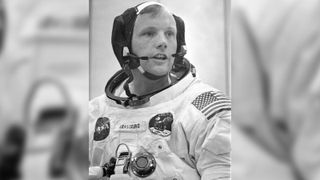
Early career and NASA work
Apollo 11 and the first moonwalk, after apollo 11, and armstrong's death, armstrong's legacy, additional resources, bibliography.
Neil Armstrong was a NASA astronaut and aeronautical engineer. He famously became the first person to walk on the moon on July 20, 1969 during Apollo 11 . Armstrong also flew on NASA's Gemini 8 mission in 1966.
He retired from NASA in 1971 and remained active in the aerospace community, although he chose to keep mostly out of the public spotlight. Armstrong died Aug. 25, 2012, at age 82.
Armstrong was famously reticent about his accomplishments, preferring to focus on the team that helped him get to the moon rather than his own first steps. "I guess we all like to be recognized not for one piece of fireworks, but for the ledger of our daily work," Armstrong said in an interview with CBS's "60 Minutes" program in 2005.
In another interview, when asked what it feels like to have his footprints remain on the moon's surface for thousands of years, Armstrong said, "I kind of hope that somebody goes up there one of these days and cleans them up," The Independent reported.
Related: Apollo landers, Neil Armstrong’s bootprint and other human artifacts on moon officially protected by new US law
Armstrong was born in Wapakoneta, Ohio, on Aug. 5, 1930, to Stephen Koenig Armstrong and Viola Louise Engel.
Neil was a naval aviator from 1949 to 1952 and served in the Korean War. He earned his bachelor of science degree in aeronautical engineering from Purdue University in 1955. (Many years later, after he became world-famous, he also received a master of science in aerospace engineering from the University of Southern California in 1970.)
Armstrong became a test pilot for NASA (then known as NACA, the National Advisory Committee for Aeronautics) and flew the X-15, a rocket-powered, missile-shaped aircraft that tested the limits of high-altitude flight. During his long career as a pilot, Armstrong flew more than 200 different aircraft, from jets to gliders and even helicopters.
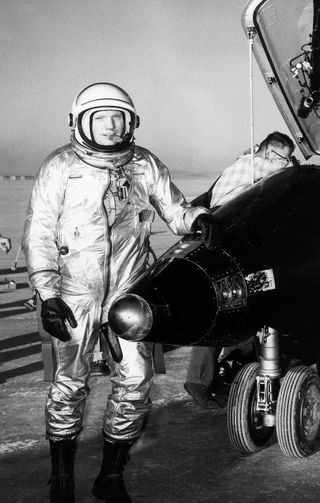
In 1962, Armstrong was selected to be part of NASA's second group of astronauts, who flew on the two-seat Gemini missions to test out space technology, and the three-seat Apollo missions that ultimately took 12 people to the surface of the moon. Armstrong's first flight was as command pilot of the Gemini 8 mission in March 1966 — the sixth crewed mission of that series.
Armstrong and pilot David Scott completed the first orbital docking of two spacecraft, joining their Gemini 8 spacecraft to an uncrewed Agena target vehicle. However, the two-man crew experienced a serious problem when a thruster on the Gemini 8 spacecraft became stuck open. With the astronauts whipping around faster than one revolution per second, Armstrong managed to gain control again by using the re-entry system thrusters. The event was the first serious emergency in space and although the mission ultimately ended safely, the spacecraft was forced to splash down early because the re-entry system was already expended.
Armstrong also narrowly avoided a nasty accident in May 1968, this time within Earth's atmosphere , while flying the Lunar Landing Research Vehicle — a machine that could fly somewhat like a lunar module and simulate landings on the moon. Fuel for the attitude thrusters ran out and Armstrong was forced to eject just seconds before the vehicle crashed, NASA reported . Armstrong escaped unharmed.

The Apollo 11 crew members were announced to the public in January 1969. NASA's chief of the Astronaut Office, Donald Kent "Deke" Slayton, chose an all-veteran team of Neil Armstrong (Gemini 8), Edwin "Buzz" Aldrin (Gemini 12) and Michael Collins (Gemini 10), with Armstrong selected to command the mission. His responsibilities included landing on the moon alongside Aldrin, the pilot of the lunar module Eagle. Collins would remain in lunar orbit aboard the command module Columbia. (Collins was originally supposed to be backup pilot for Apollo 11, but his spot in the flight sequence was moved after required surgery on his back forced him off the prime crew for Apollo 8.)
As the lander approached the moon, Armstrong took over the controls when he saw that the computer was guiding them to a boulder-filled landing zone. At 4:14 p.m. EDT (2014 GMT), Armstrong and Aldrin landed on the moon, with only 25 seconds of fuel left. Armstrong radioed, "Houston, Tranquility Base here. The Eagle has landed." Capsule communicator and astronaut Charles Duke responded from Earth: "Roger … Tranquility, we copy you on the ground. You got a bunch of guys about to turn blue. We're breathing again. Thanks a lot."
The schedule called for the astronauts to sleep before the first moonwalk, but they elected to go outside early because they felt they would not be able to sleep. In view of a black-and-white television camera transmitting his movements live to Earth, Armstrong descended Eagle's lander and touched his left foot upon the surface at 10:56 p.m. EDT July 20 (0256 GMT July 21). His first words were "That's one small step for a man, one giant leap for mankind." (The "a" was lost to radio static, but later analysis of the sound wave showed that Armstrong did say it.)
Armstrong and Aldrin together explored the surface during a moonwalk that lasted 2 hours and 36 minutes. They collected 48.5 pounds (22 kilograms) of material from the surface — including 50 moon rocks — as well as deploying experiments, planting the U.S. flag and taking a moment to speak with the U.S. president at the time, Richard Nixon.
The Eagle's crew lifted off safely from the moon on July 21, docked with Columbia, and voyaged back to Earth for a successful ocean landing on July 24. The astronauts went into quarantine to mitigate the (unlikely) risk that they were carrying some sort of moon germs back with them, and then embarked on a world tour to celebrate the mission.
After his time as an astronaut, Armstrong was deputy associate administrator for aeronautics at NASA headquarters . He resigned from NASA in 1971. From 1971 to 1979, he was a professor of aerospace engineering at the University of Cincinnati. Then from 1982 to 1992, Armstrong was chairman of Computing Technologies for Aviation Inc. in Charlottesville, Virginia. Armstrong also participated in the Rogers Commission, which was a presidential commission tasked to look at the causes and events of the fatal Challenger shuttle explosion of Jan. 28, 1986, that killed seven astronauts.
Armstrong chose to mostly stay out of the spotlight after leaving NASA, although he did reappear periodically for interviews or for anniversary events concerning Apollo 11. Although his public statements were few, he followed spaceflight news and occasionally made public comments on what was happening. He remained a vocal supporter of suborbital spaceflight. On the other hand, the former Apollo astronaut was publicly critical of plans to shift crewed spaceflight from NASA to private spacecraft.
On Aug. 7, 2012 — two days after Armstrong turned 82 years old — the famed moonwalker underwent coronary bypass surgery. Complications from the surgery resulted in his death on Aug. 25.
"Neil was our loving husband, father, grandfather, brother and friend," his family wrote on the website neilarmstronginfo.com. "For those who may ask what they can do to honor Neil, we have a simple request," they added. "Honor his example of service, accomplishment and modesty, and the next time you walk outside on a clear night and see the moon smiling down at you, think of Neil Armstrong and give him a wink."
Tributes poured in from many public figures, including President Barack Obama, Republican presidential candidate Mitt Romney, then-NASA administrator Charles Bolden, Apollo 11 crewmates Aldrin and Collins, and various space representatives in the public, private and nonprofit spheres.
"Neil was among the greatest of American heroes — not just of his time, but of all time," Obama's statement read . "When he and his fellow crew members lifted off aboard Apollo 11 in 1969, they carried with them the aspirations of an entire nation. They set out to show the world that the American spirit can see beyond what seems unimaginable — that with enough drive and ingenuity, anything is possible."
A private memorial service for Armstrong was held Aug. 31, 2012, at the Camargo Club in Cincinnati. Two weeks later, a publicly televised memorial service was held at the National Cathedral in Washington, D.C.
Armstrong was buried at sea Sept. 14, 2012, in a ceremony aboard the guided missile cruiser USS Philippine Sea. Armstrong's family was on board when the ship left port in Mayport, Florida, and they released his ashes somewhere in the Atlantic Ocean. Obama ordered flags around the United States to fly at half-staff on the day of the funeral.
In 2015, the Smithsonian Institution revealed that Armstrong had kept aside a cloth bag full of small parts from the lunar module Eagle, which lay undiscovered for decades until his widow, Carol, found it. While Armstrong made no mention of this bag in decades of interviews, the bag was discussed a few times during the mission.
It is unknown how Armstrong ultimately gained possession of the bag, but it was common during the Apollo years for astronauts to retain souvenirs of their flights. (A month after Armstrong's death, Obama made legal a bill to allow Mercury, Gemini and Apollo astronauts to retain legal title to these mementos.) Former "Mythbusters" host Adam Savage subsequently created a carry bag based on the design of Armstrong's "purse"; the design was actually used in several Apollo missions before and after Apollo 11.
On Jul. 21, 2009, Neil Armstrong, Michael Collins, and Buzz Aldrin attended the U.S House of Representatives Committee on Science and Technology tribute to the Apollo 11 Astronauts at the Cannon House Office Building on Capitol Hill. During the ceremony, the committee presented the astronauts with a copy of House Resolution 607 honoring their achievements and announced the passage of legislation awarding them and John Glenn the Congressional Gold Medal.

In a 2013 BBC documentary, Armstrong's brother, Dean, said that he knew of the famous first words on the moon several months before Apollo 11 touched down. Dean reported that Armstrong passed him a handwritten note as the brothers played a late-night game of Risk, according to British newspaper the Telegraph. However, Dean's remarks contradicted many statements by Armstrong himself, who said that the words didn't come to him until he arrived on the moon. The other Apollo 11 astronauts have also backed up Armstrong's assertions.
In 2017, a rare gold lunar model was stolen from the Armstrong Air and Space Museum in Wapakoneta. "Entry to the museum was discovered and taken was a solid gold replica of the 1969 Lunar Excursion Module that landed on the moon," Russel Hunlock, Wapakoneta police chief, said in a release. "The piece is very rare as it was presented to Neil Armstrong in Paris, France, shortly after the moon landing."
On Oct. 12, 2018, Universal Pictures released a Neil Armstrong biography based on James R. Hansen's book "First Man: The Life of Neil A. Armstrong." The movie starred Ryan Gosling as Armstrong. The movie was embroiled in political controversy because the filmmakers decided not to include a scene where Armstrong plants an American flag on the moon's surface, despite the fact that Armstrong did so in reality. Sen. Marco Rubio, a Republican from Florida, tweeted, "This is total lunacy. And a disservice at a time when our people need reminders of what we can achieve when we work together."
At the Venice Film Festival Gosling defended the filmmaker's choice, reported The Telegraph , saying, "I think [the moon landing] was widely regarded in the end as a human achievement [and] that's how we chose to view it."
On Aug. 11, 2021, NASA dedicated the Ohio test facility to Neil Armstrong . Armstrong had graciously declined the honor when he was originally asked, but on Wednesday (Aug. 11), nine years after Armstrong died and a week after what would have been his 91st birthday, a group of NASA officials and members of Congress gathered at a small dedication ceremony in Sandusky, Ohio. NASA’s Plum Brook Station is now known as The Neil A. Armstrong Test Facility.
You can explore 50 Neil Armstrong facts with this article from Facts.net or read about Armstrong's life and dreams of space travel in this book by James R. Hansen. Discover more about Armstrong in this informative article published by the Air and Space Museum.
- Sylvia Doughty Fries “ NASA Engineers and the Age of Apollo ”, The NASA History Series.
- Hansen, James R. “ First Man: The Life of Neil A. Armstrong ”. Simon and Schuster, 2012.
Join our Space Forums to keep talking space on the latest missions, night sky and more! And if you have a news tip, correction or comment, let us know at: [email protected].
Get the Space.com Newsletter
Breaking space news, the latest updates on rocket launches, skywatching events and more!
Elizabeth Howell (she/her), Ph.D., is a staff writer in the spaceflight channel since 2022 covering diversity, education and gaming as well. She was contributing writer for Space.com for 10 years before joining full-time. Elizabeth's reporting includes multiple exclusives with the White House and Office of the Vice-President of the United States, an exclusive conversation with aspiring space tourist (and NSYNC bassist) Lance Bass, speaking several times with the International Space Station, witnessing five human spaceflight launches on two continents, flying parabolic, working inside a spacesuit, and participating in a simulated Mars mission. Her latest book, " Why Am I Taller ?", is co-written with astronaut Dave Williams. Elizabeth holds a Ph.D. and M.Sc. in Space Studies from the University of North Dakota, a Bachelor of Journalism from Canada's Carleton University and a Bachelor of History from Canada's Athabasca University. Elizabeth is also a post-secondary instructor in communications and science at several institutions since 2015; her experience includes developing and teaching an astronomy course at Canada's Algonquin College (with Indigenous content as well) to more than 1,000 students since 2020. Elizabeth first got interested in space after watching the movie Apollo 13 in 1996, and still wants to be an astronaut someday. Mastodon: https://qoto.org/@howellspace
International Space Station: Live updates
Next Blue Origin space tourism flight will launch youngest woman above the Kármán line
Get a sneak peek at upcoming 'Avatar Land' in Disney's California Adventure Park
- Truthseeker007 How do you know he was the first human? Reply
- some people never understand and choose to remain ignorant Reply
- Neil Armstrong I'm Still alive Reply
Neil Armstrong said: I'm Still alive
- View All 4 Comments
Most Popular
- 2 The Cassiopeia constellation is surrounded by celestial treasures. Here's how to see them
- 3 How will the stuck Boeing Starliner astronauts perceive time after 6 months in space?
- 4 SpaceX launching private Polaris Dawn astronaut mission Aug. 27: How to watch online
- 5 Emax Tinyhawk III Plus Freestyle RTF drone kit review

Suggested Searches
- Climate Change
- Expedition 64
- Mars perseverance
- SpaceX Crew-2
- International Space Station
- View All Topics A-Z
Humans in Space
Earth & climate, the solar system, the universe, aeronautics, learning resources, news & events.

FAQ: NASA’s Boeing Crew Flight Test Return Status
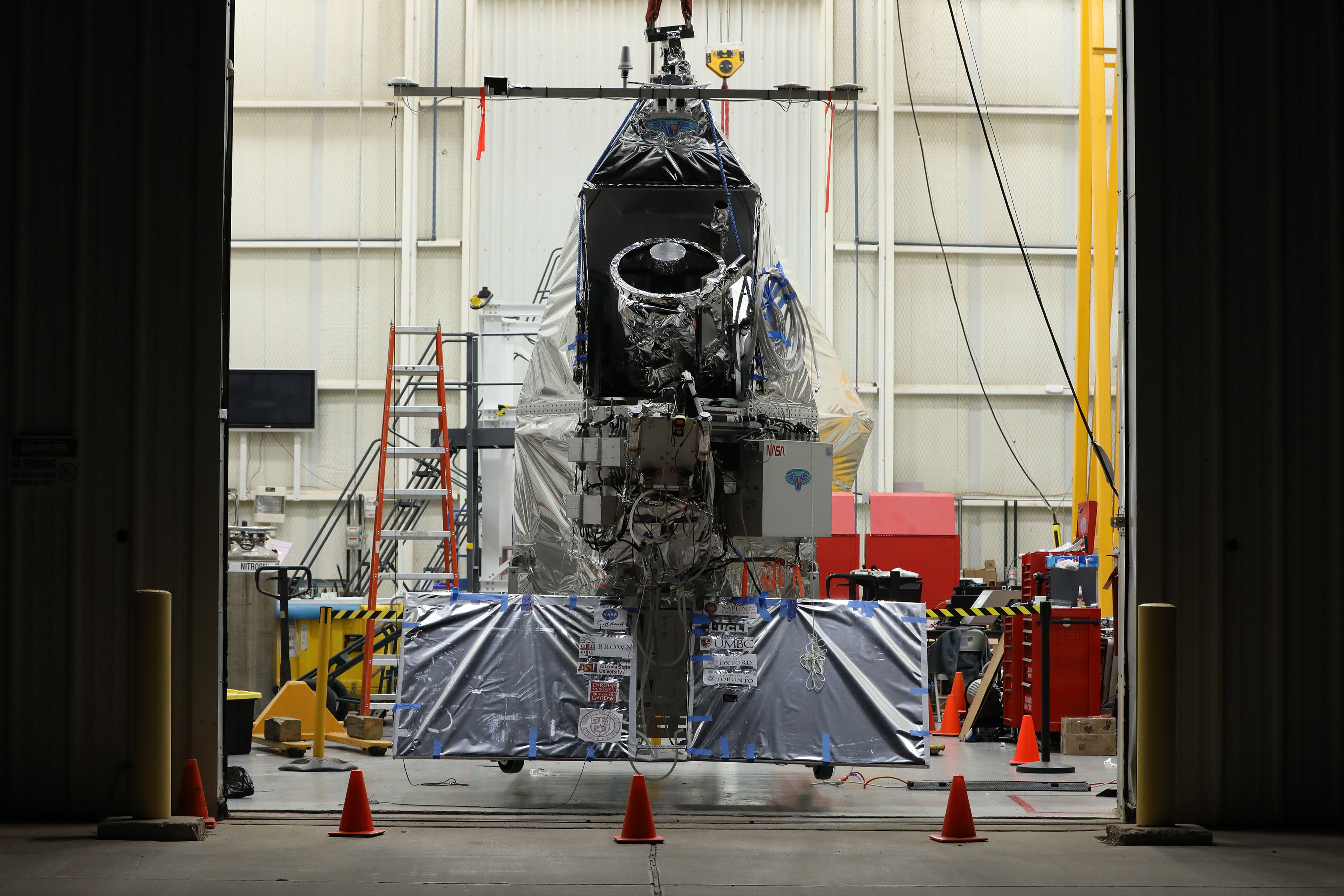
NASA’s EXCITE Mission Prepared for Scientific Balloon Flight
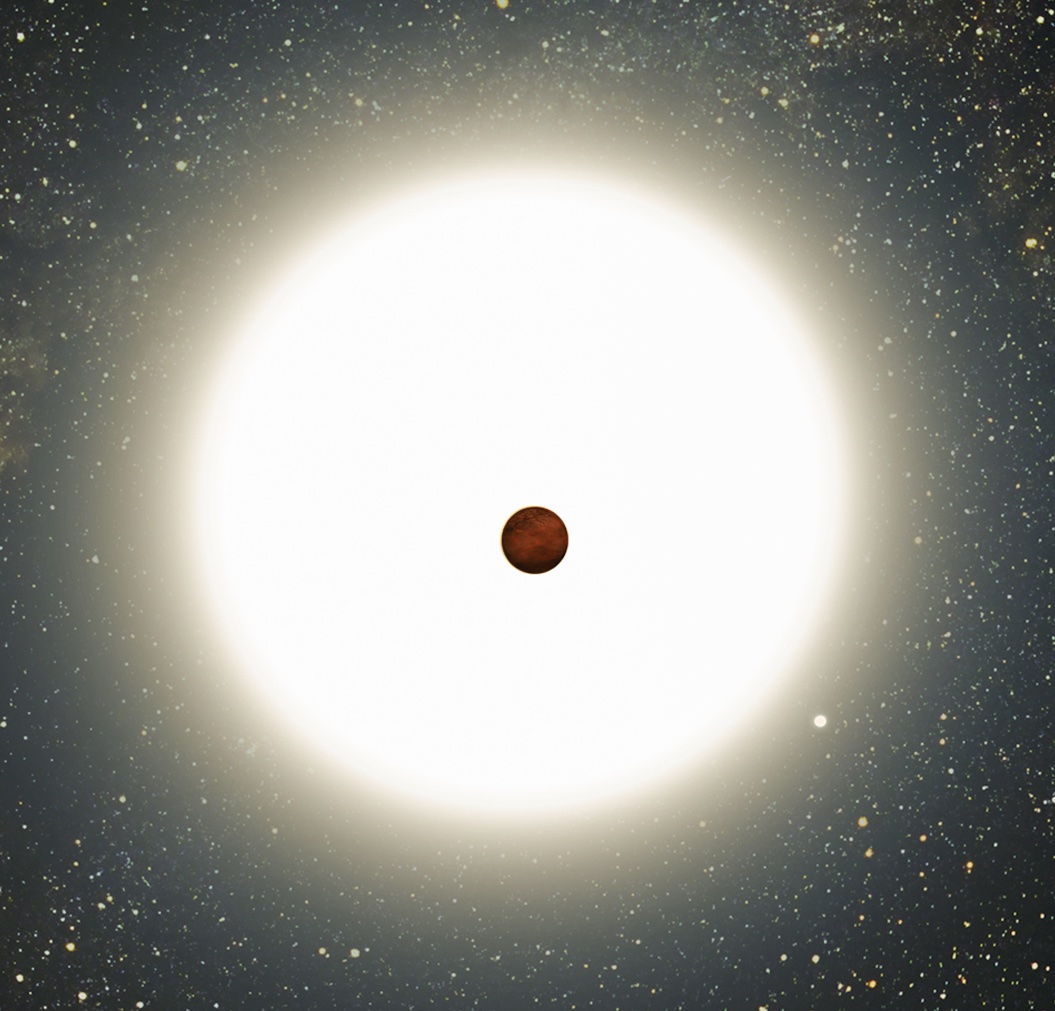
Talented Teams Tackle Toasty Planet
- Search All NASA Missions
- A to Z List of Missions
- Upcoming Launches and Landings
- Spaceships and Rockets
- Communicating with Missions
- James Webb Space Telescope
- Hubble Space Telescope
- Why Go to Space
- Commercial Space
- Destinations
- Living in Space
- Explore Earth Science
- Earth, Our Planet
- Earth Science in Action
- Earth Multimedia
- Earth Science Researchers
- Pluto & Dwarf Planets
- Asteroids, Comets & Meteors
- The Kuiper Belt
- The Oort Cloud
- Skywatching
- The Search for Life in the Universe
- Black Holes
- The Big Bang
- Dark Energy & Dark Matter
- Earth Science
- Planetary Science
- Astrophysics & Space Science
- The Sun & Heliophysics
- Biological & Physical Sciences
- Lunar Science
- Citizen Science
- Astromaterials
- Aeronautics Research
- Human Space Travel Research
- Science in the Air
- NASA Aircraft
- Flight Innovation
- Supersonic Flight
- Air Traffic Solutions
- Green Aviation Tech
- Drones & You
- Technology Transfer & Spinoffs
- Space Travel Technology
- Technology Living in Space
- Manufacturing and Materials
- Science Instruments
- For Kids and Students
- For Educators
- For Colleges and Universities
- For Professionals
- Science for Everyone
- Requests for Exhibits, Artifacts, or Speakers
- STEM Engagement at NASA
- NASA's Impacts
- Centers and Facilities
- Directorates
- Organizations
- People of NASA
- Internships
- Our History
- Doing Business with NASA
- Get Involved
NASA en Español
- Aeronáutica
- Ciencias Terrestres
- Sistema Solar
- All NASA News
- Video Series on NASA+
- Newsletters
- Social Media
- Media Resources
- Upcoming Launches & Landings
- Virtual Events
- Image of the Day
- Sounds and Ringtones
- Interactives
- STEM Multimedia
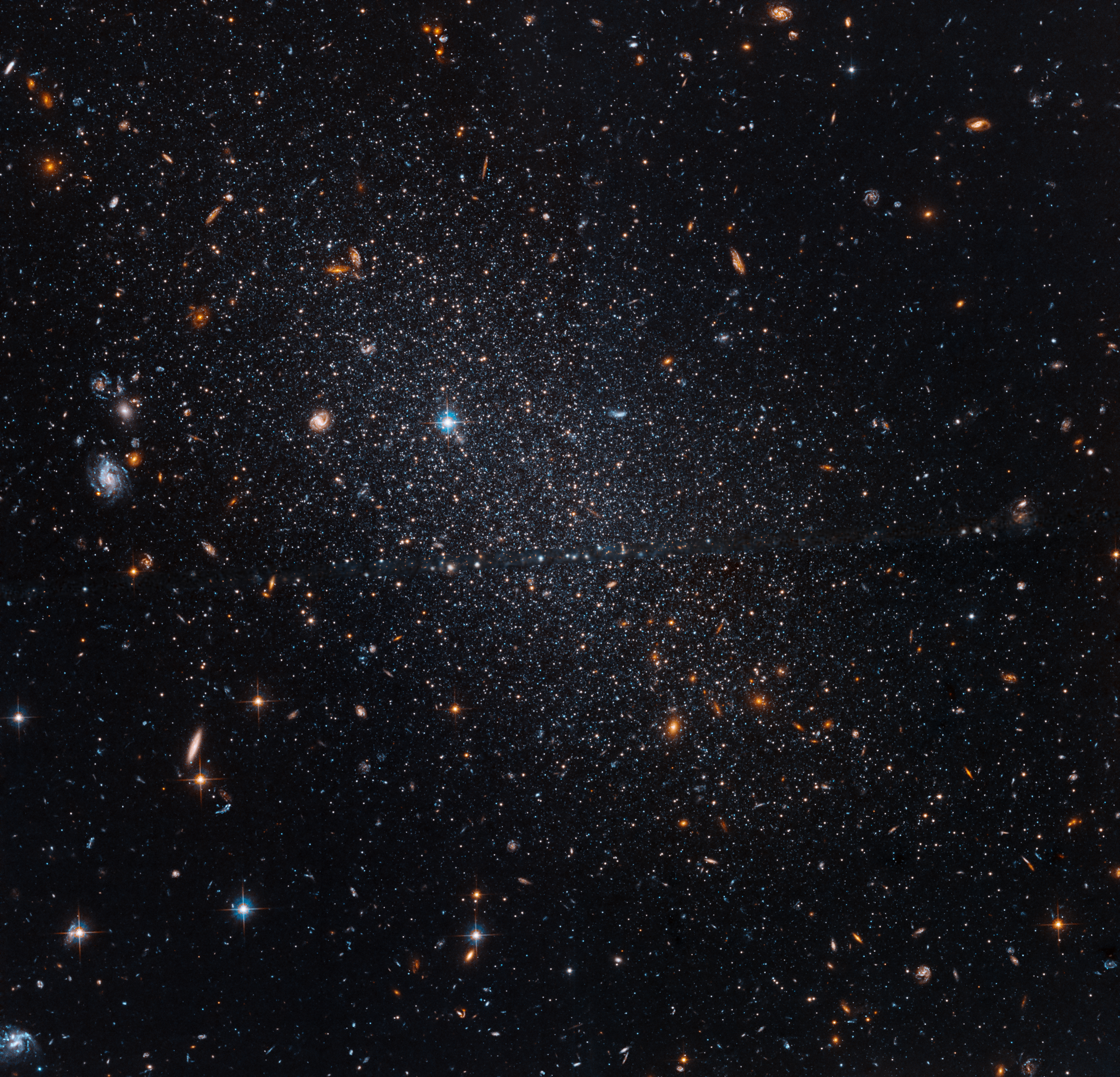
Hubble Reaches a Lonely Light in the Dark

NASA Funds Studies to Support Crew Performance on Long-Duration Missions
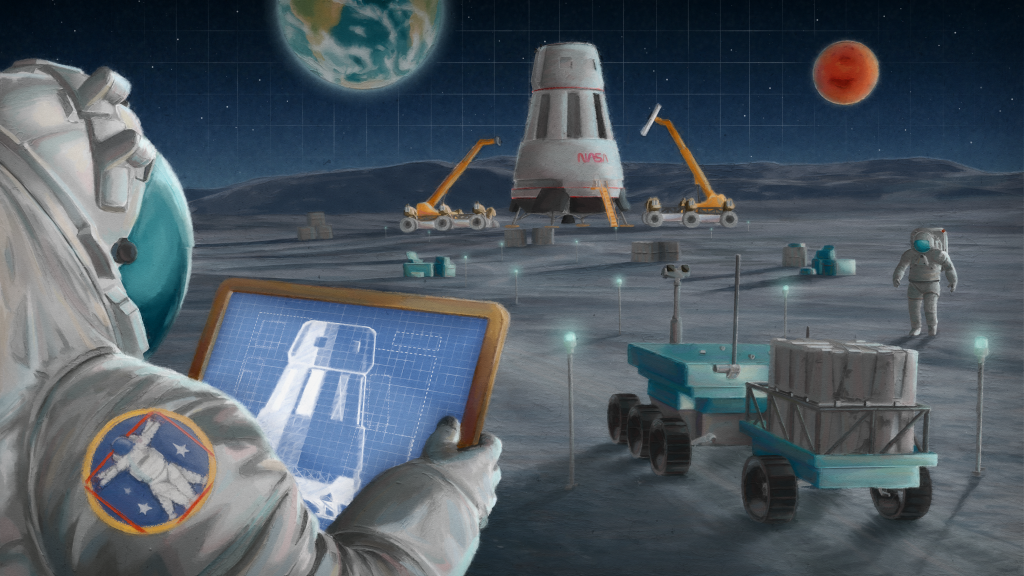
NextSTEP R: Lunar Logistics and Mobility Studies
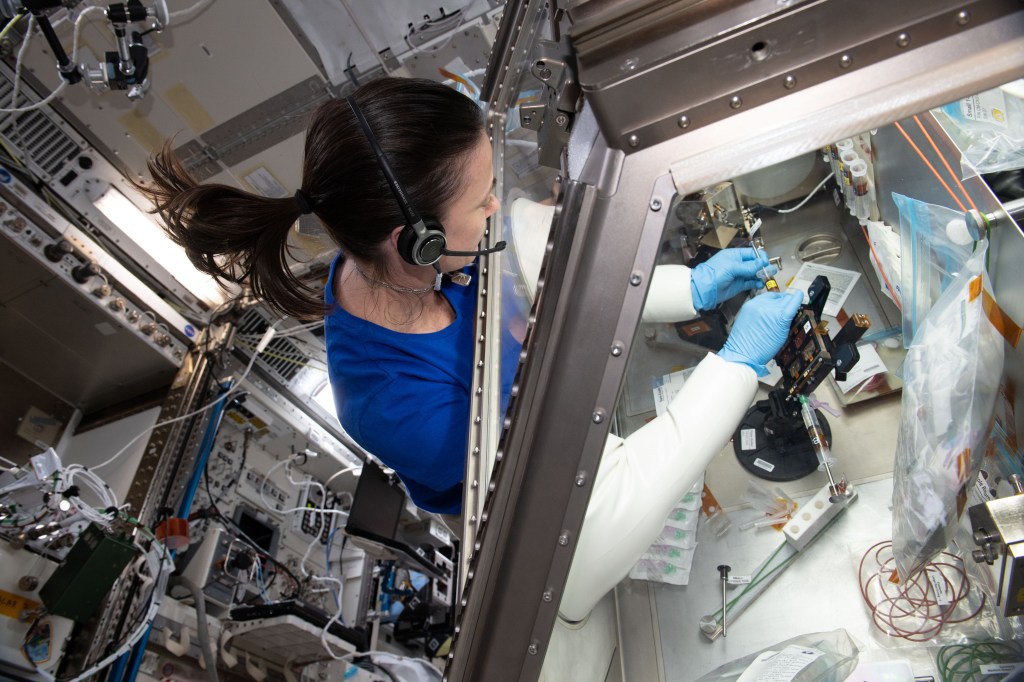
Station Science Top News: August 16, 2024
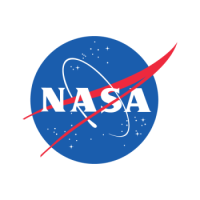
STV Precursor Coincident Datasets
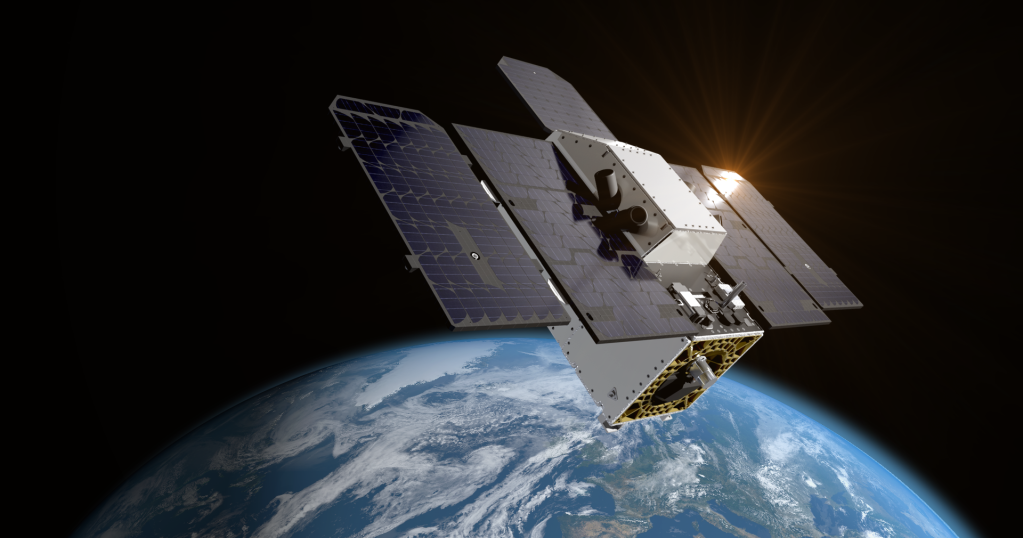
NASA-Designed Greenhouse Gas-Detection Instrument Launches
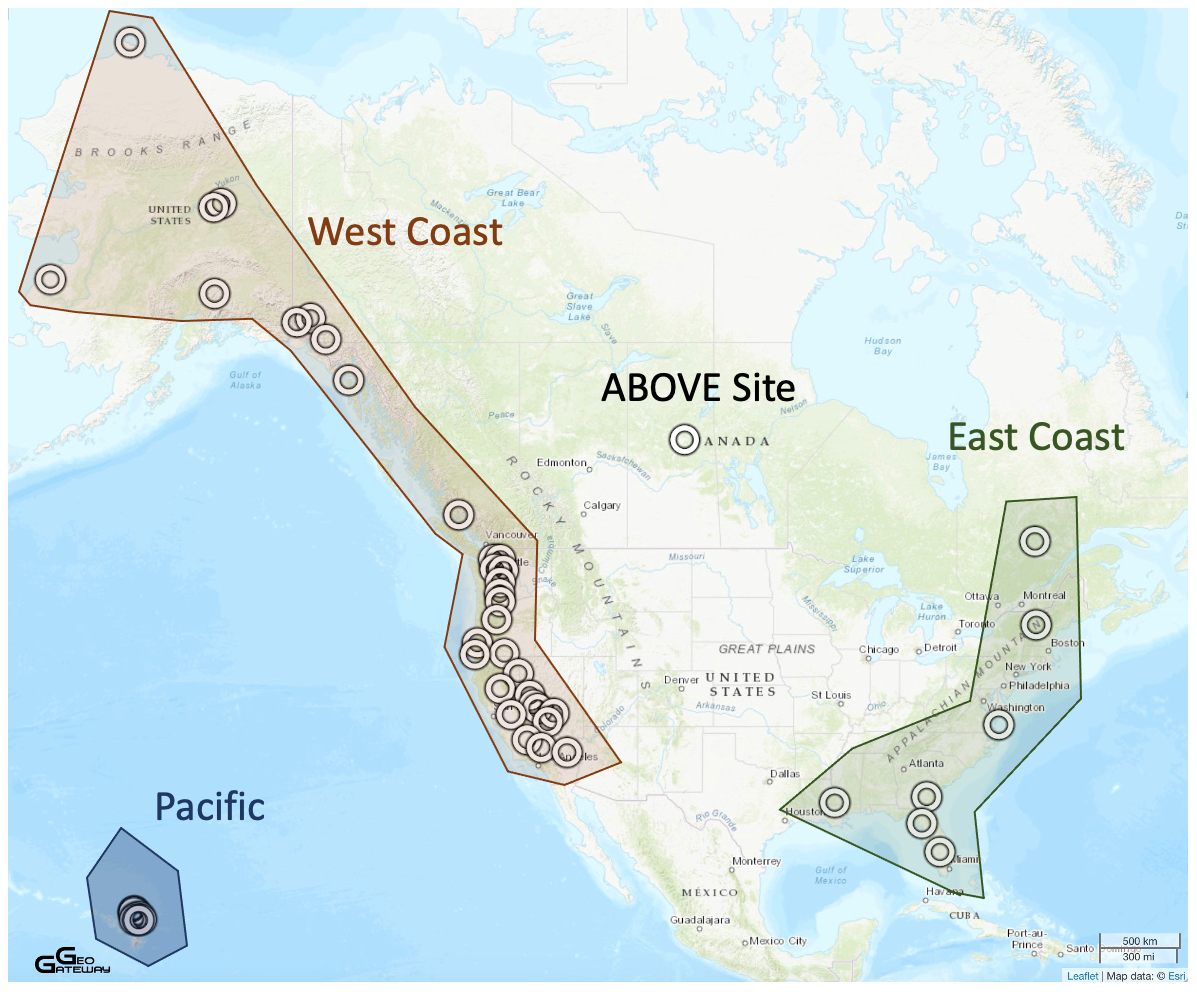
Airborne Surface, Cryosphere, Ecosystem, and Nearshore Topography
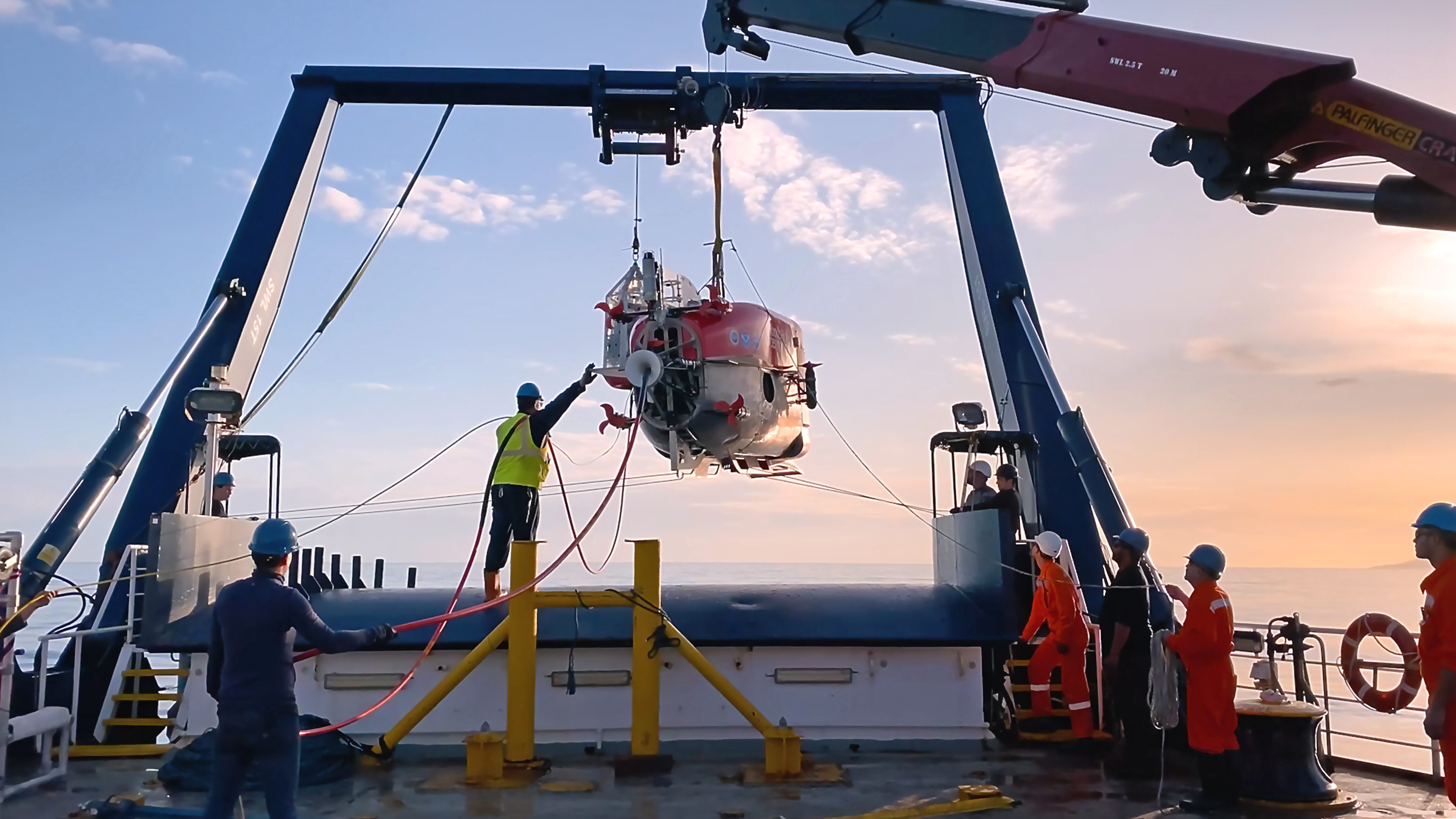

The Making of Our Alien Earth: The Undersea Volcanoes of Santorini, Greece

NASA Shares Asteroid Bennu Sample in Exchange with JAXA
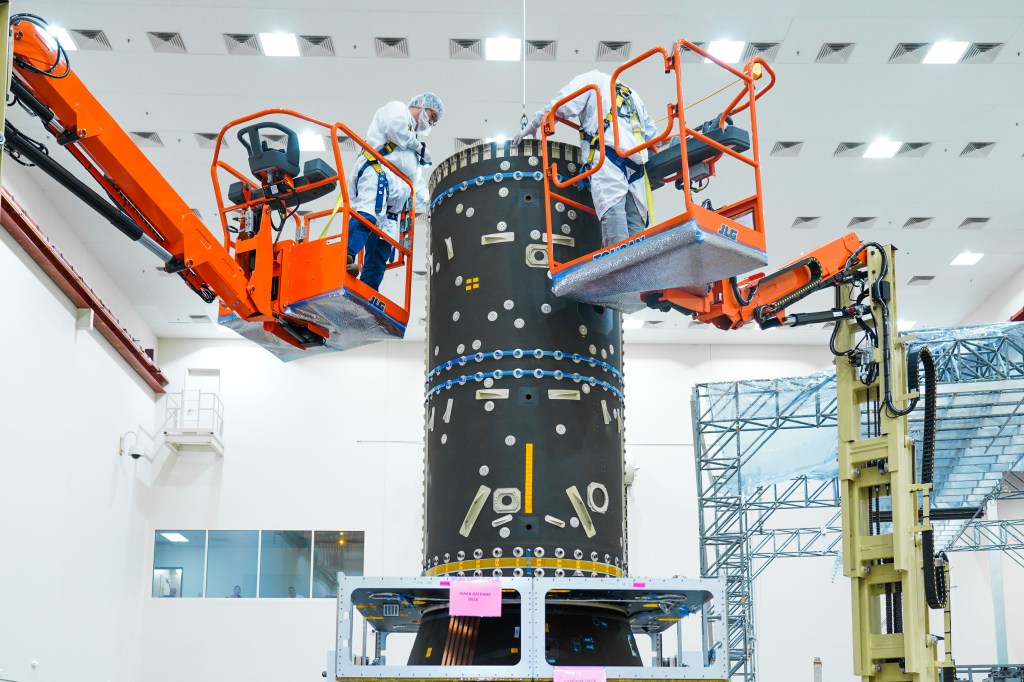
Gateway: Energizing Exploration

Hubble Finds Structure in an Unstructured Galaxy
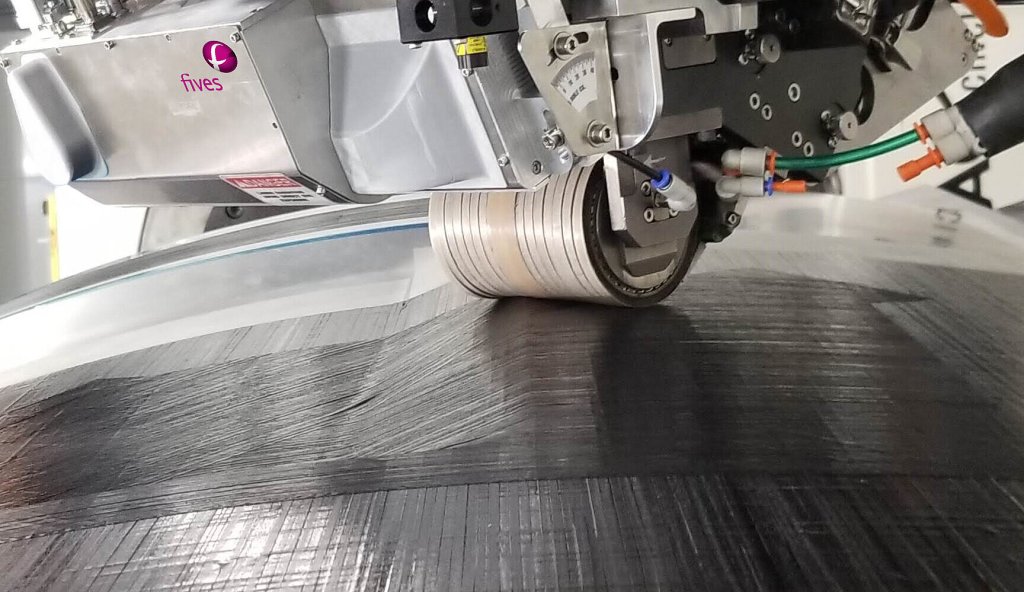
NASA Composite Manufacturing Initiative Gains Two New Members
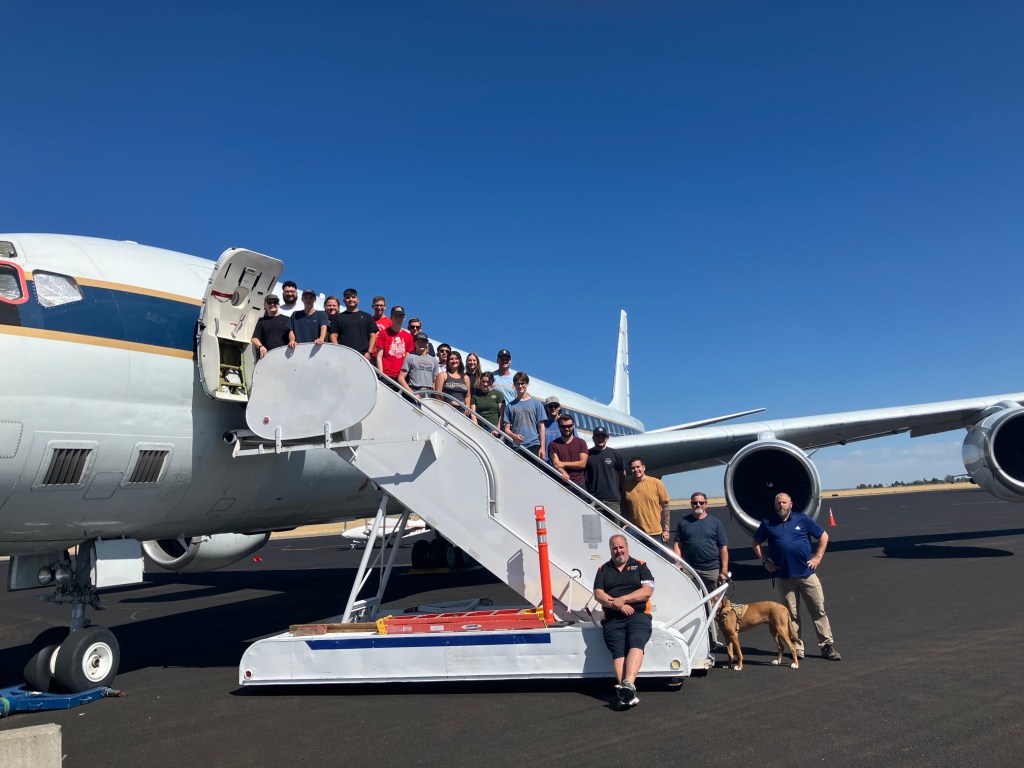
Beyond the Textbook: DC-8 Aircraft Inspires Students in Retirement

NASA Celebrates Ames’s Legacy of Research on National Aviation Day

Copernicus Trajectory Design and Optimization System
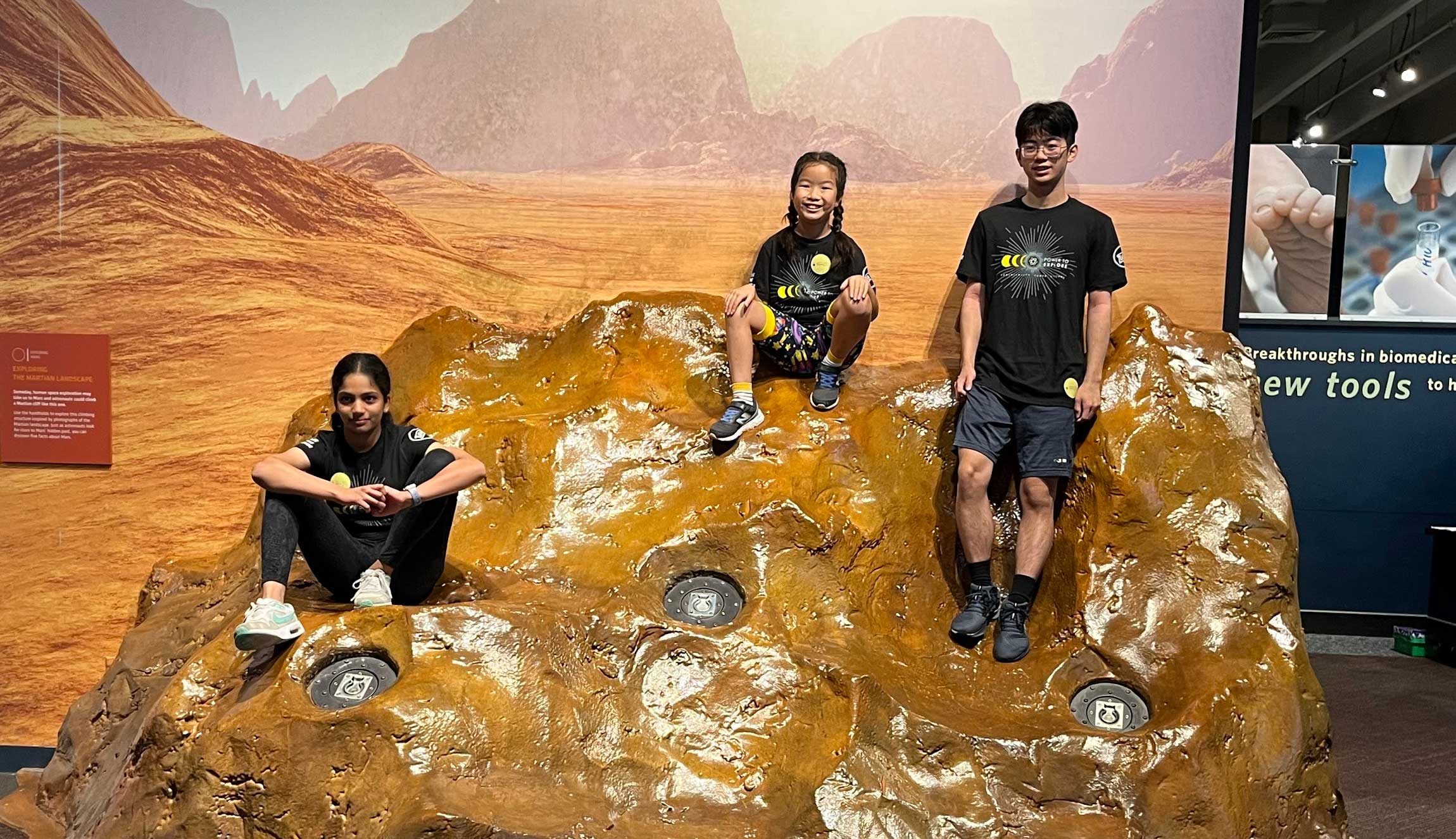
Perseverance Pays Off for Student Challenge Winners

How Do I Navigate NASA Learning Resources and Opportunities?
Preguntas frecuentes: estado del retorno de la prueba de vuelo tripulado boeing de la nasa.

Astronauta de la NASA Frank Rubio

Diez maneras en que los estudiantes pueden prepararse para ser astronautas
To view this video please enable JavaScript, and consider upgrading to a web browser that supports HTML5 video
Farther and Faster: NASA’s Journey to the Moon with Artemis
At 1:47 a.m. EST (6:47 UTC) on Nov. 16, 2022, NASA’s Orion spacecraft launched atop the SLS (Space Launch System) rocket from historic Launch Pad 39B at NASA’s Kennedy Space […]
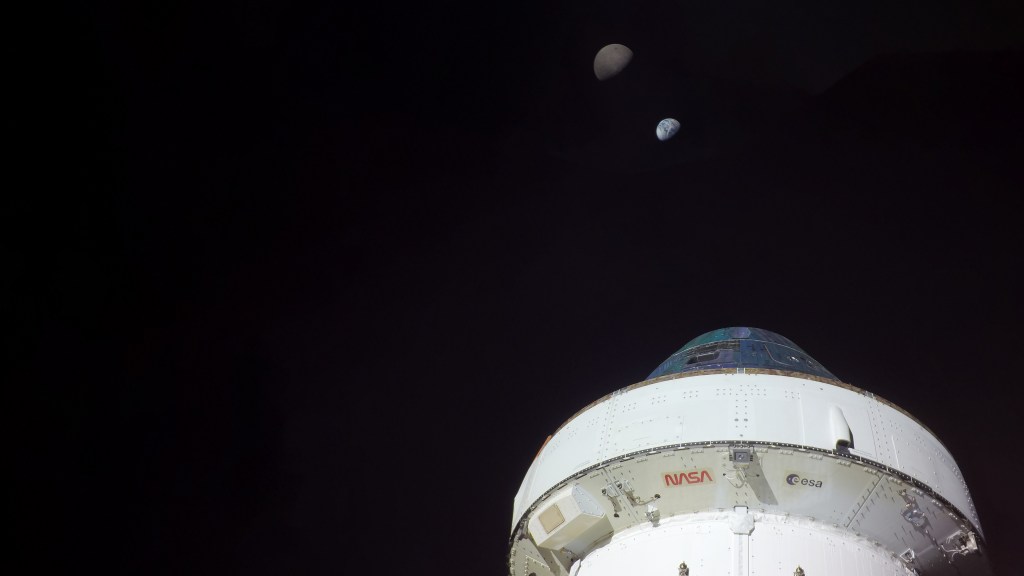
- Open Video Player
- WhatsApp https://plus.nasa.gov/video/farther-faster/ Copy URL to clipboard> Share
At 1:47 a.m. EST (6:47 UTC) on Nov. 16, 2022, NASA’s Orion spacecraft launched atop the SLS (Space Launch System) rocket from historic Launch Pad 39B at NASA’s Kennedy Space Center in Florida on a path to the Moon, officially beginning the Artemis I mission.
Over the course of 25.5 days, Orion performed two lunar flybys, coming within 80 miles (129 kilometers) of the lunar surface. At its farthest distance during the mission, Orion traveled nearly 270,000 miles (435,000 kilometers) from our home planet. On Dec. 11, 2022, NASA’s Orion spacecraft successfully completed a parachute-assisted splashdown in the Pacific Ocean at 9:40 a.m. PST (12:40 p.m. EST) as the final major milestone of the Artemis I mission.
Artemis I set new records of performance, exceeded efficiency expectations, and established new safety baselines for humans in deep space. This is a prelude to what comes next—following the success of Artemis I, human beings will fly around the Moon on Artemis II.
We have demonstrated our ability to go farther and faster than ever before, opening the door to explore Mars and other destinations throughout the solar system. This is the story of Artemis I.
Artemis II: Meet the Astronauts Who will Fly Around the Moon
Nasa explorers: we are the artemis generation, artemis: we are focused, first look at artemis i.
- Page Last Updated: Aug 23, 2024
- Responsible NASA Official: Rebecca Sirmons

Suggested Searches
- Climate Change
- Expedition 64
- Mars perseverance
- SpaceX Crew-2
- International Space Station
- View All Topics A-Z
Humans in Space
Earth & climate, the solar system, the universe, aeronautics, learning resources, news & events.

FAQ: NASA’s Boeing Crew Flight Test Return Status

NASA’s EXCITE Mission Prepared for Scientific Balloon Flight

Talented Teams Tackle Toasty Planet
- Search All NASA Missions
- A to Z List of Missions
- Upcoming Launches and Landings
- Spaceships and Rockets
- Communicating with Missions
- James Webb Space Telescope
- Hubble Space Telescope
- Why Go to Space
- Commercial Space
- Destinations
- Living in Space
- Explore Earth Science
- Earth, Our Planet
- Earth Science in Action
- Earth Multimedia
- Earth Science Researchers
- Pluto & Dwarf Planets
- Asteroids, Comets & Meteors
- The Kuiper Belt
- The Oort Cloud
- Skywatching
- The Search for Life in the Universe
- Black Holes
- The Big Bang
- Dark Energy & Dark Matter
- Earth Science
- Planetary Science
- Astrophysics & Space Science
- The Sun & Heliophysics
- Biological & Physical Sciences
- Lunar Science
- Citizen Science
- Astromaterials
- Aeronautics Research
- Human Space Travel Research
- Science in the Air
- NASA Aircraft
- Flight Innovation
- Supersonic Flight
- Air Traffic Solutions
- Green Aviation Tech
- Drones & You
- Technology Transfer & Spinoffs
- Space Travel Technology
- Technology Living in Space
- Manufacturing and Materials
- Science Instruments
- For Kids and Students
- For Educators
- For Colleges and Universities
- For Professionals
- Science for Everyone
- Requests for Exhibits, Artifacts, or Speakers
- STEM Engagement at NASA
- NASA's Impacts
- Centers and Facilities
- Directorates
- Organizations
- People of NASA
- Internships
- Our History
- Doing Business with NASA
- Get Involved
NASA en Español
- Aeronáutica
- Ciencias Terrestres
- Sistema Solar
- All NASA News
- Video Series on NASA+
- Newsletters
- Social Media
- Media Resources
- Upcoming Launches & Landings
- Virtual Events
- Image of the Day
- Sounds and Ringtones
- Interactives
- STEM Multimedia

Hubble Reaches a Lonely Light in the Dark

NASA Funds Studies to Support Crew Performance on Long-Duration Missions

NextSTEP R: Lunar Logistics and Mobility Studies

Station Science Top News: August 16, 2024

STV Precursor Coincident Datasets

NASA-Designed Greenhouse Gas-Detection Instrument Launches

Airborne Surface, Cryosphere, Ecosystem, and Nearshore Topography

The Making of Our Alien Earth: The Undersea Volcanoes of Santorini, Greece

NASA Shares Asteroid Bennu Sample in Exchange with JAXA

Gateway: Energizing Exploration

Hubble Finds Structure in an Unstructured Galaxy

NASA Composite Manufacturing Initiative Gains Two New Members

Beyond the Textbook: DC-8 Aircraft Inspires Students in Retirement

NASA Celebrates Ames’s Legacy of Research on National Aviation Day

Copernicus Trajectory Design and Optimization System

Perseverance Pays Off for Student Challenge Winners

How Do I Navigate NASA Learning Resources and Opportunities?
Preguntas frecuentes: estado del retorno de la prueba de vuelo tripulado boeing de la nasa.

Astronauta de la NASA Frank Rubio

Diez maneras en que los estudiantes pueden prepararse para ser astronautas
There and back again: how nasa’s journey to the moon paved a path home.
Frank Tavares
“I believe that this nation should commit itself to achieving the goal, before this decade is out, of landing a man on the Moon and returning him safely to the Earth.”
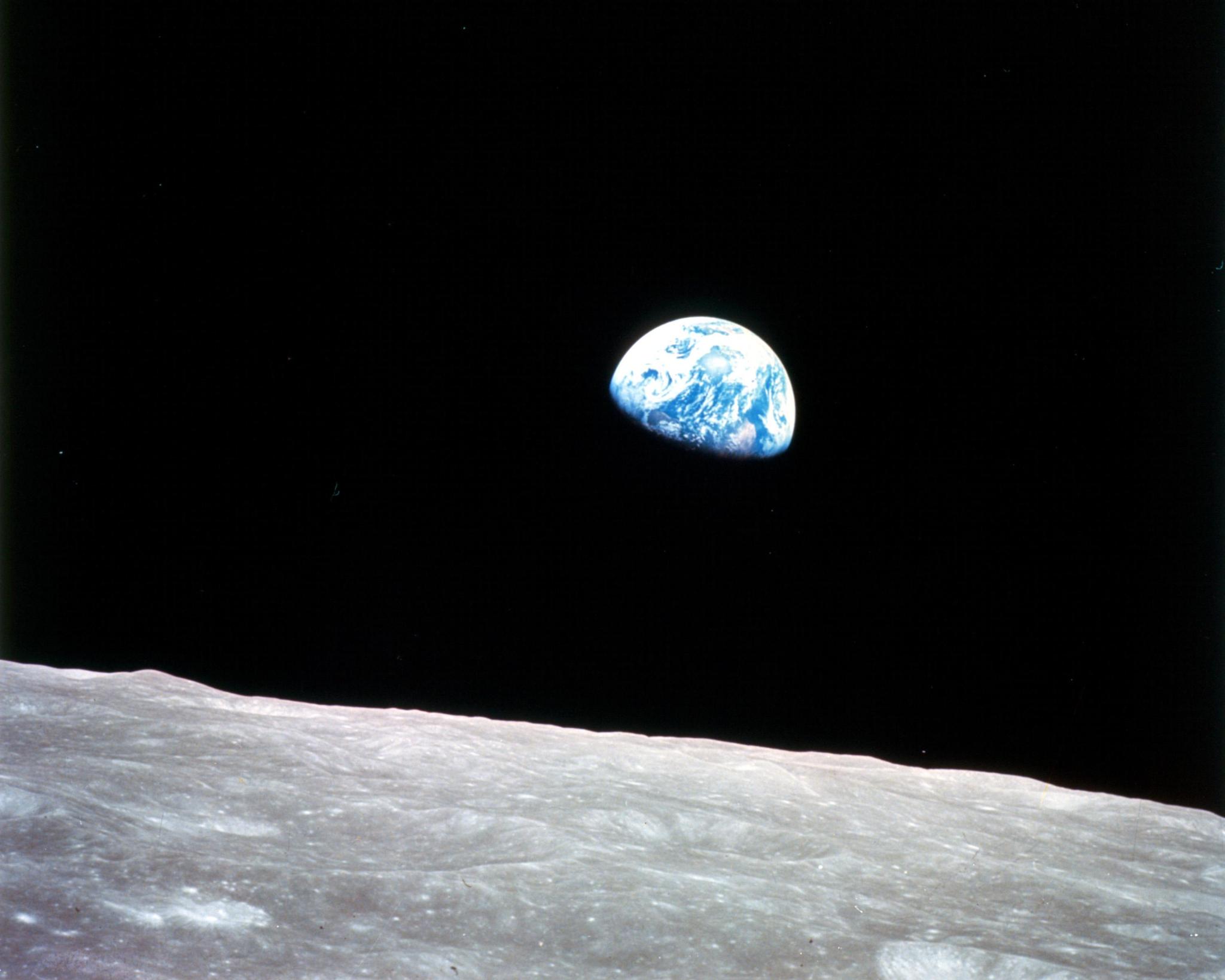
When President John F. Kennedy declared this to Congress in May 1961, humans had barely brushed past the outer edge of Earth’s atmosphere.
Only a month earlier, the Soviet Union sent the first human to space, while America’s furthest foray at that time was Alan Shephard’s 15-minute flight that fell short of entering Earth’s orbit. Between that history-making speech and Neil Armstrong’s first step on the lunar surface in 1969 is the story of how NASA ensured our voyage to the Moon had a way to get back home.
There were almost an infinite number of ways for it all to go wrong, especially during the most dangerous part of the mission – reentering Earth’s atmosphere. The hypersonic speeds and intense heat of reentry were extreme and largely unfamiliar conditions. NASA had to develop entirely new vehicles and areas of research to protect the vulnerable astronauts within.
NASA continues to build on these innovations in spaceflight that first led us to the Moon, now solving new problems with our commercial partners as the agency moves forward to the Moon and even further to Mars.
But before all that, we had to find a way to safely bring astronauts to the Moon and back again. That journey begins with the design of a spaceship.
A Visionary Engineer for a New Challenge
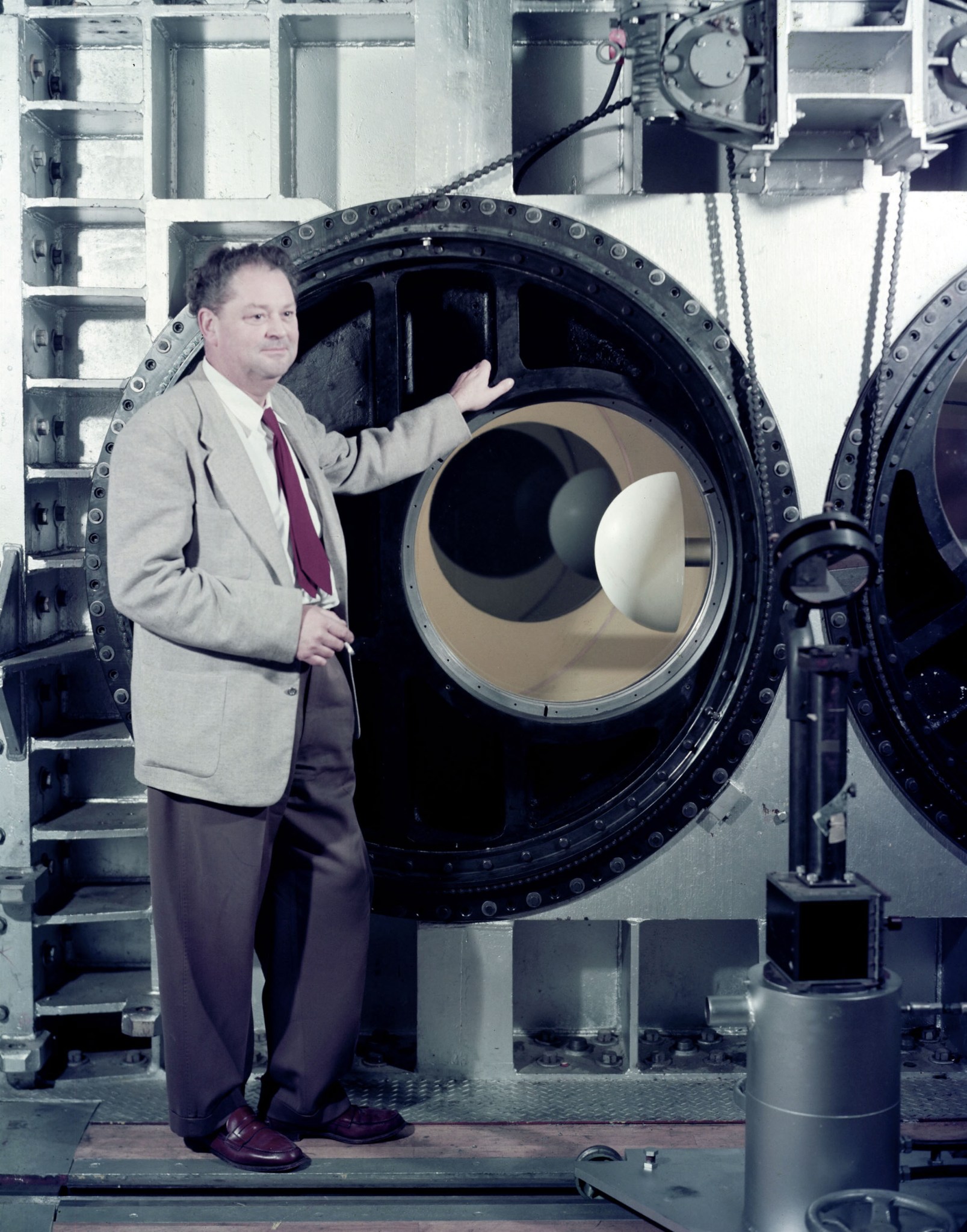
Picture a child’s drawing of a spaceship: wide on the bottom with fins and a fiery blaster, and a pointed tip to slice through the atmosphere at high speeds. At the dawn of the Space Age, this was humanity’s conception of what a spaceship should look like. The problem: a pointy-tipped spacecraft would melt on reentry from space. Aerospace engineer “Harvey” Julian Allen took up this problem and in solving it opened up the possibility of human spaceflight.
Allen’s work began during World War II as he helped design war planes and missiles with pointy tips that provided the aerodynamic precision needed for Allied victory. In 1940, he made his way to California and Ames Aeronautical Laboratory.
Strategically positioned on the West Coast in what has become the heart of Silicon Valley, today’s Ames Research Center was founded at the start of the war in 1939 to boost America’s aeronautical prowess. It became the second laboratory for aerodynamics research under the National Advisory Committee for Aeronautics , or NACA.
At this precursor agency to NASA, Allen understood the “normal” conditions of aviation would simply not work for extreme travel. An eccentric and deeply curious engineer, he rose through the ranks and created a work culture that fostered collaboration and creativity. Under Allen’s leadership, his new research lab was poised to tackle the problems of reentering Earth’s atmosphere.
A Solution Takes Shape
The gaseous layers of Earth’s atmosphere create a kind of barrier around our planet, shielding us from some of the dangerous radiation from the Sun. In our everyday experience, we only move through the lowest layer of the atmosphere. But even here, we can get a sense of how strong the resistance of air molecules can be. Just stick a hand out of a car traveling on the highway at 60 miles per hour.
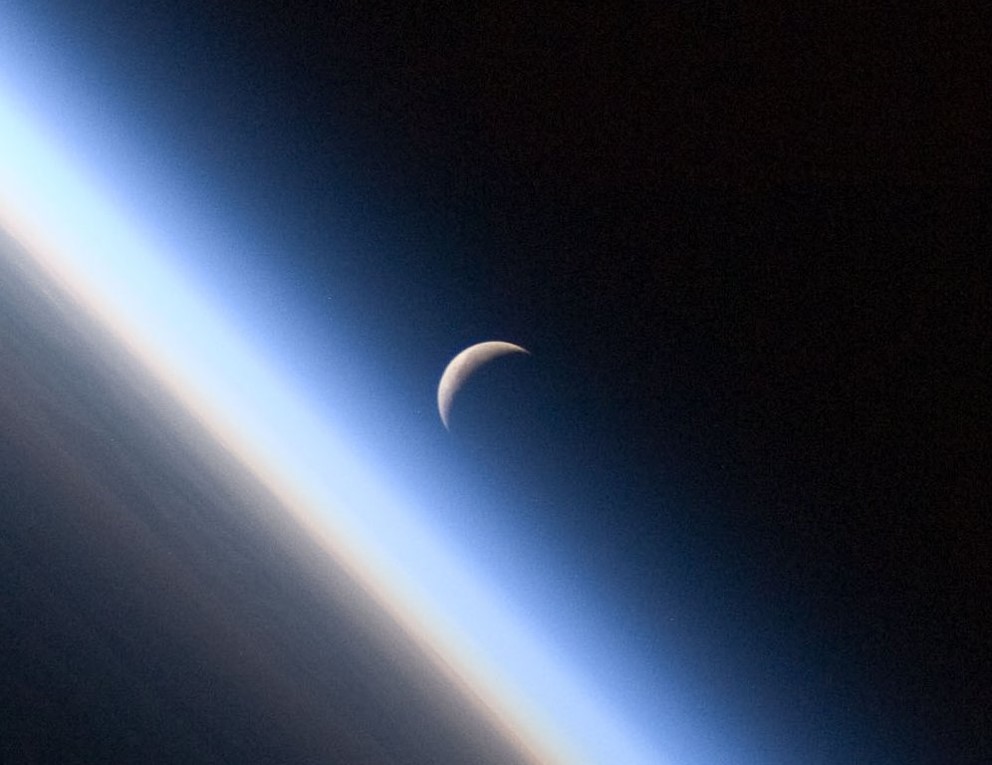
Now picture traveling at 24,600 miles per hour – the speed of the Apollo 11 space capsule on its return trip from the Moon. That speed is hypersonic, meaning many times faster than the speed of sound. At speeds this fast, an incredible amount of heat is generated in part by the friction between the spacecraft and air molecules, but mainly from the compression of air in the form of a shockwave created by the spacecraft careening through the atmosphere. Plasma, the substance of stars, forms between the shockwave and the vehicle at peak heating conditions.
Tasked with solving the reentry problem for long-range ballistic missiles, Allen in 1951 developed a theory that would go on to become the foundation for rocket design for the Space Age continuing to this day. His solution: instead of a pointy tip to a spacecraft, make it blunt. Blunted shapes still create shockwaves, but further away from the body so that more of the heat flows around the spacecraft instead of into its surface. With most of the heat of reentry flowing away from the spacecraft, the crew or cargo inside can be more easily protected.
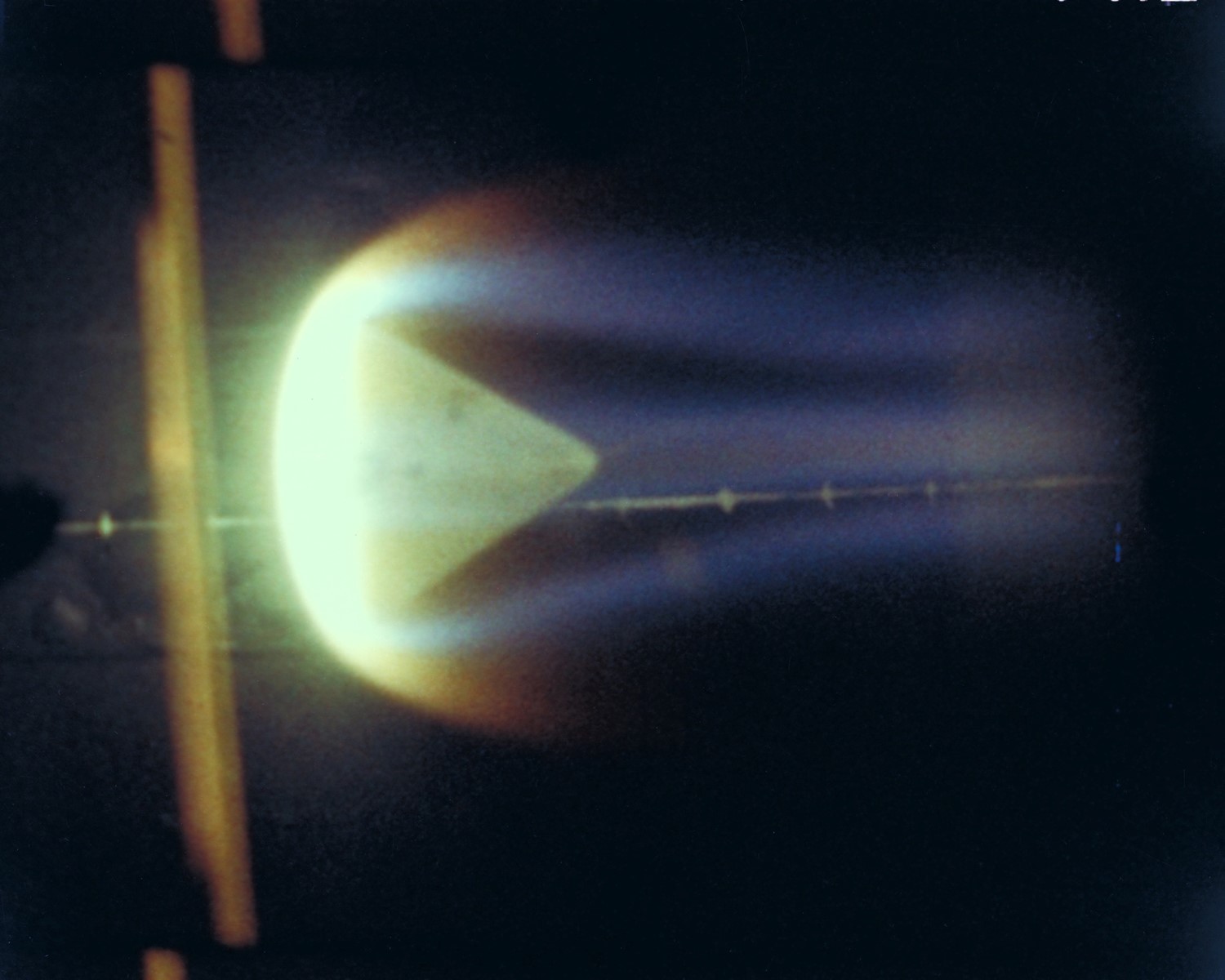
Turning Up the Heat
Allen’s “blunt-body theory” became instrumental when NASA was founded in 1958 as America’s space agency, with its first major task to put an astronaut into orbit under Project Mercury. Kennedy’s 1961 directive to put humans on the Moon propelled the research into a full-blown science and engineering endeavor into the design of protective caps placed on the nose of space capsules, known as heat shields.
A facility known as the Arc Jet Complex was built to test heat shield materials and design. A chamber simulated reentry conditions by artificially creating plasma at temperatures of about 3,000 degrees Fahrenheit and blasting it at high speeds against the heat shield test models to see how they performed. The Ames facility helped develop the shape and material composition of heat shields that would be integrated onto the Apollo capsules.
Meanwhile, Allen stepped into the role of center director for Ames from 1965 to 1969. Under his direction, the center became a construction site for new facilities that would test out every stage of the journey to the Moon. Ames facilities were used to simulate aerodynamics at the extreme speeds encountered upon returning from the Moon.
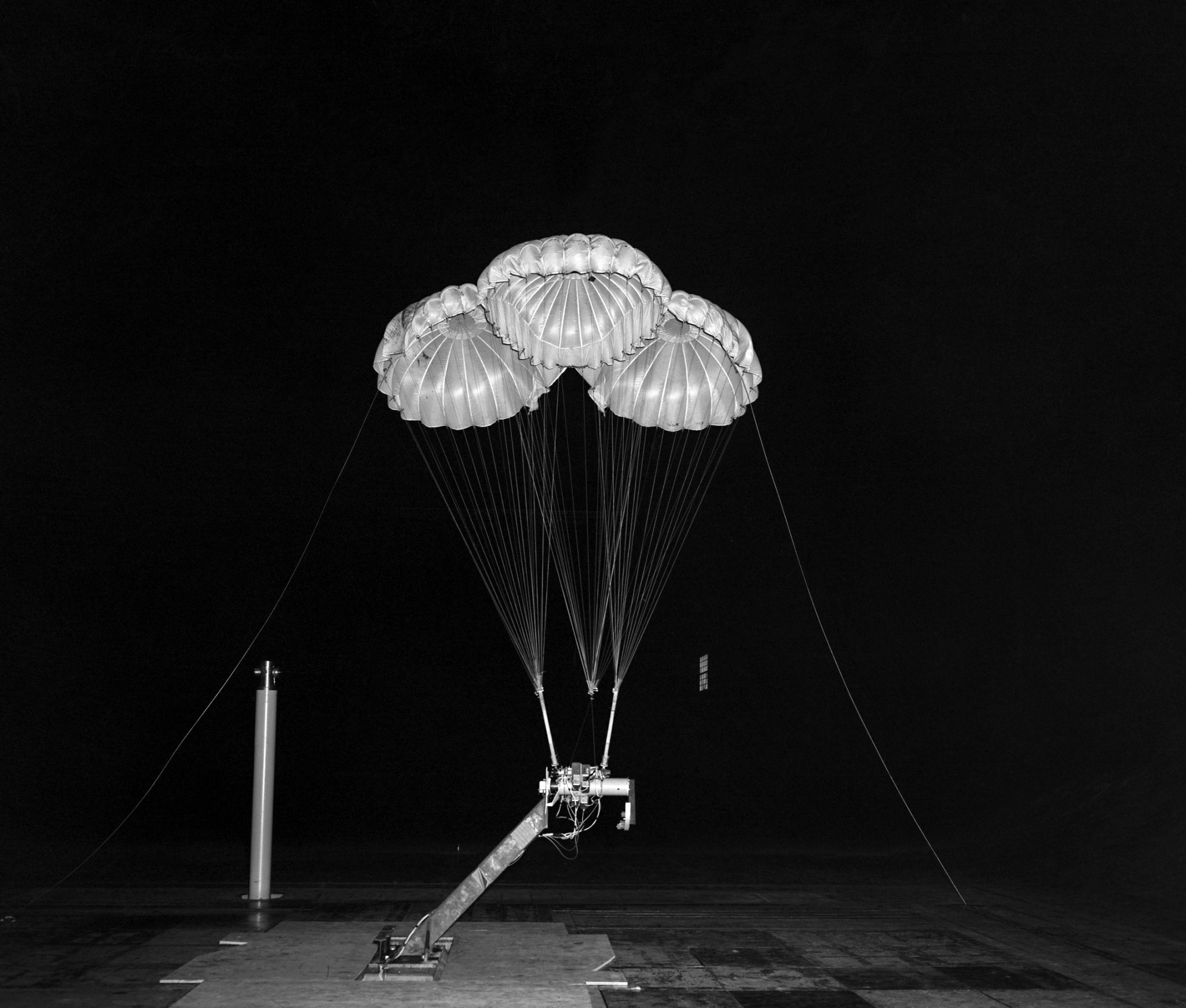
From NASA facilities came solutions to obstacles that just a few years before seemed insurmountable. Models for the now famous Saturn V rocket and Apollo lunar landers were tested and iterated upon to create the most aerodynamically efficient designs for launch. Simulators allowed astronauts to practice their journey to the Moon and descent to its surface until it became muscle memory. And to safely reenter through the atmosphere, heatshields built from Allen’s blunt body designs used ablative materials to withstand the extreme environments of atmospheric entry. The iconic three-parachute system – tested to ensure it could slow the crew capsule’s fall – could then safely bring the crew to the Pacific Ocean’s surface.
From launch until landing, the Apollo astronauts would be covered.
And then, on one otherwise ordinary summer evening in 1969, all that preparation, research and testing coalesced into a single moment as the first human footprint was placed on the Moon.
President Kennedy’s dream of taking humans to the lunar surface and back again became a reality, less than a decade after those words left his lips. Meanwhile, Harvey Allen retired and, ever the dabbler, began investigating personal curiosities, such as the aerodynamics of owls and their silent flight.
NASA’s mission continued as the innovators and explorers who were brought together in service of that singular accomplishment looked towards the next journeys beyond Earth.
Forward to the Moon and Beyond
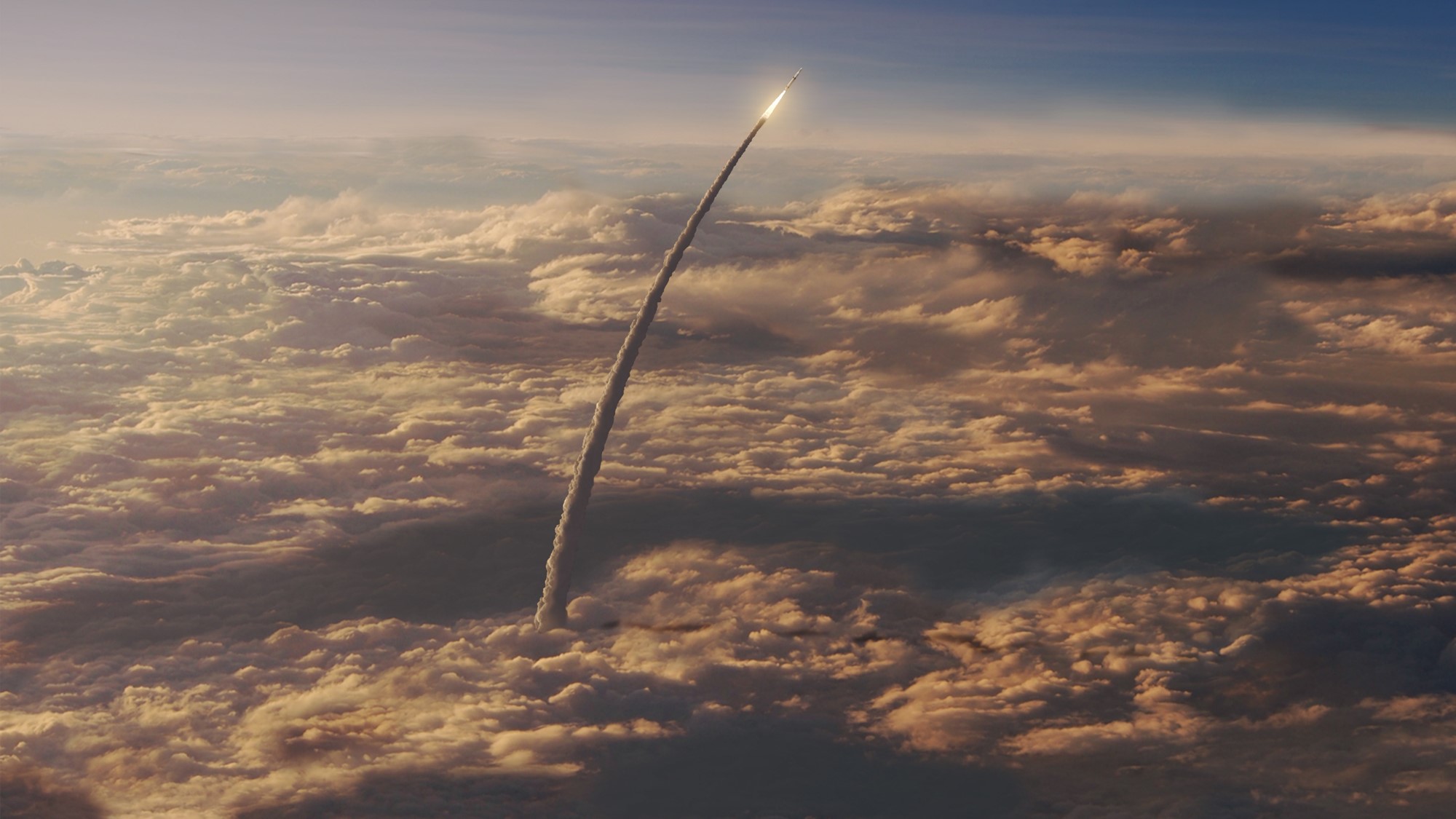
Today, NASA’s center in Silicon Valley is doing the same work for the Artemis program , the agency’s new lunar exploration program. Under Artemis, NASA will send the first woman and next man to the Moon by 2024, and establish sustainable exploration by 2028. Using our new deep space transportation system in development, the Space Launch System rocket will send crew aboard the Orion spacecraft to the Gateway in lunar orbit. From the Gateway, crew will travel to the surface of the Moon and back to the Gateway in a new integrated human landing system.
Future exploration requires a new generation of heatshields and tools for testing.
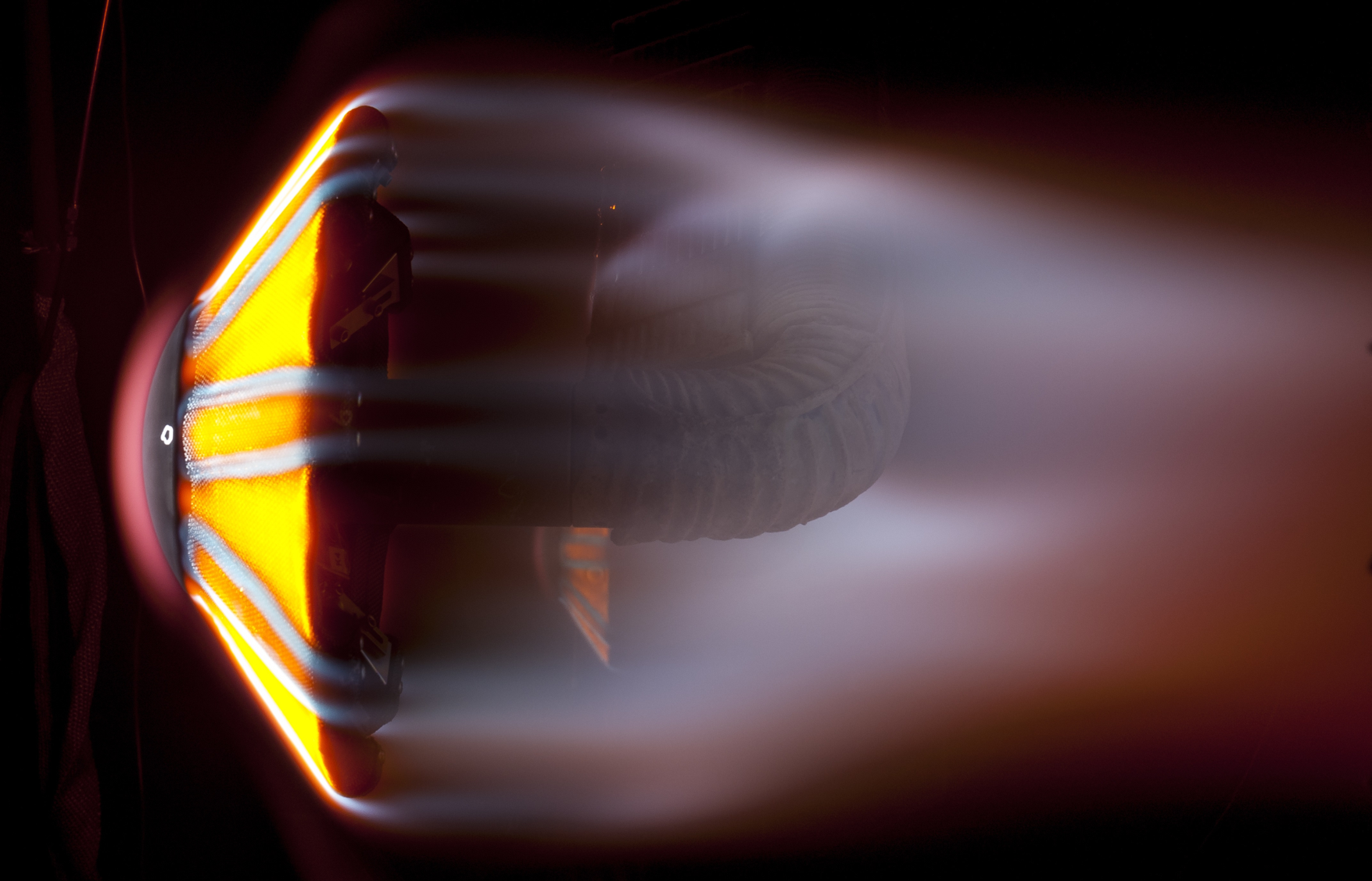
Our modern rocket testing begins with tools that allow us to be more precise, even when using the same wind tunnels from 50 years ago. Pressure sensitive paint can reveal every slight effect of intense speeds on a model. New facilities such as our supercomputers allow us to simulate launch and digitally test for every possible scenario, adjusting and iterating until every variable is accounted for.
The Moon is our stepping-stone for Mars, and even as we work to ensure our systems can safely take us there and back, we’re also looking ahead to what could someday become future destinations. Modern heat shields will be able to protect robotic explorers as well, withstanding the even more intense temperatures of places like Venus. They will even be flexible enough to adapt to the diverse environments on the moons of Jupiter and Saturn. ADEPT – the Adaptable, Deployable Entry Placement Technology – can open and close like an umbrella. When it needs to be small, the heat shield can be tightly packed up to fit into a confined rocket, but can protect larger spacecraft once deployed. It’ll allow us to take larger robotics and more materials on longer voyages to Mars and to worlds in the outer solar system, and one day, safely bring samples from those worlds back to Earth.
The shielding itself is getting an upgrade, too. The Heatshield for Extreme Entry Environment Technology project , known as HEEET, uses an all-carbon layer 3D weave with an insulating layer of carbon and synthetic yarns to create an interlocking and versatile protective material.
Just like Allen’s blunt body was needed to safely pass through the then-unfamiliar environment of our upper atmosphere, these new technologies will ensure our spacecraft can survive the future unexplored atmospheres of the solar system’s many destinations. No matter how far we journey into the stars, we’re developing the technology to safely get back home.
Author: Frank Tavares, NASA’s Ames Research Center

IMAGES
COMMENTS
NASA/Newsmakers/Getty Images. On July 20, 1969, American astronauts Neil Armstrong (1930-2012) and Edwin "Buzz" Aldrin (1930-) became the first humans ever to land on the moon. About six-and-a ...
Apollo 11, U.S. spaceflight during which commander Neil Armstrong and lunar module pilot Edwin ("Buzz") Aldrin, Jr., on July 20, 1969, became the first people to land on the Moon and walk the lunar surface. Apollo 11 was the culmination of the Apollo program and a massive national commitment by the United States to beat the Soviet Union in ...
Apollo 11. / 13.317°N 169.150°W / 13.317; -169.150 ( Apollo 11 splashdown) / 0.67416; 23.47314. Apollo 11 was a spaceflight conducted by the United States from July 16 to July 24, 1969. It marked the first time in history that humans landed on the Moon.
Apollo 11 Mission Highlights. Watch highlights of the Apollo 11 mission including the launch on July 16, 1969, the landing of the lunar module, Neil Armstrong's first steps on the Moon, splashdown, and more. Watch on NASA+. 20 July 1969—Astronaut Edwin E. Aldrin Jr., lunar module pilot, walks on the surface of the moon near the leg of the ...
On July 19, after Apollo 11 had flown behind the moon out of contact with Earth, came the first lunar orbit insertion maneuver. At about 75 hours, 50 minutes into the flight, a retrograde firing of the SPS for 357.5 seconds placed the spacecraft into an initial, elliptical-lunar orbit of 69 by 190 miles.
Two hours and 44 minutes after liftoff, the third stage engine ignited for the six-minute TLI burn, increasing the spacecraft's velocity to more than 24,000 miles per hour, enough to escape Earth's gravity. Armstrong called down to the ground after the burn, "That Saturn gave us a magnificent ride. It was beautiful.".
The mission that took U.S. astronauts to the Moon was Apollo 11, NASA's fifth crewed Apollo mission. The astronauts on board the spacecraft were Neil Armstrong, Edwin ("Buzz") Aldrin, Jr., and Michael Collins. On the morning of July 20, Armstrong and Aldrin crawled from the command module, Columbia, through a tunnel to the lunar module ...
On July 20, 1969, a human walked on the Moon for the first time. Relive the full journey to and from the the Moon with the timeline below. Vice President Spiro Agnew and former President Lyndon B. Johnson view the liftoff of Apollo 11 from pad 39A. July 16, 1969. 13:32:00 UTC (Universal Coordinated Time)
NASA. October 3, 2017. Credit. NASA. Language. english. The approximately 250,000-mile journey from Earth to the moon took Apollo astronauts about three days. The closest look we've had at the moon came from the launch of NASA's Apollo program in the 1960s. Between 1967 and 1972, a series of missions landed the first men on the moon.
The Moon landing is a pivotal moment in human history, marking the first time that mankind set foot on another celestial body. It was a monumental achievement that captured the world's imagination and sparked a new era of space exploration .On July 20, 1969, NASA's Apollo 11 mission successfully landed astronauts Neil Armstrong and Buzz Aldrin ...
Neil Armstrong (1930‑2012) was a U.S. astronaut who became the first human to walk on the moon on July 20, 1969, as part of the Apollo 11 mission.
Project Apollo Archive/NASA. The mission that took U.S. astronauts to the Moon was Apollo 11, NASA's fifth crewed Apollo mission.; The astronauts on board the spacecraft were Neil Armstrong, Edwin ("Buzz") Aldrin, Jr., and Michael Collins.; The spacecraft was launched from Cape Kennedy (now Cape Canaveral), Florida, on July 16, 1969.; Hundreds of thousands of people witnessed the launch ...
A Trip to the Moon (French: Le voyage dans la lune) [a] is a 1902 French science-fiction adventure trick film written, directed and produced by Georges Méliès.Inspired by Jules Verne's 1865 novel From the Earth to the Moon and its 1870 sequel Around the Moon, the film follows a group of astronomers who travel to the Moon in a cannon-propelled capsule, explore the Moon's surface, escape from ...
The Moon Landing. The historic event captivated the world—and helped people look to the future. On July 20, 1969, millions of people gathered around their televisions to watch two U.S. astronauts do something no one had ever done before. Wearing bulky space suits and backpacks of oxygen to breathe, Neil Armstrong and Edwin "Buzz" Aldrin ...
He famously became the first person to walk on the moon on July 20, 1969 during Apollo 11. Armstrong also flew on NASA's Gemini 8 mission in 1966. He retired from NASA in 1971 and remained active ...
A Cinematic Journey to the Moon. The 2019 documentary "Apollo 11" offers a compelling and meticulously crafted look at one of humanity's most monumental achievements: the moon landing. Directed and edited by Todd Douglas Miller, this film leverages newly restored footage from the historic 1969 mission to provide viewers with a fresh perspective ...
Neil Armstrong was an American astronaut and the first person to set foot on the Moon. After joining the space program in 1962, he became the command pilot of Gemini 8, which completed the first manual space docking maneuver. He is best known for accompanying Edwin E. Aldrin, Jr., to the surface of the Moon on July 20, 1969.
From the Earth to the Moon: A Direct Route in 97 Hours, 20 Minutes (French: De la Terre à la Lune, trajet direct en 97 heures 20 minutes) is an 1865 novel by Jules Verne.It tells the story of the Baltimore Gun Club, a post-American Civil War society of weapons enthusiasts, and their attempts to build an enormous Columbiad space gun and launch three people - the Gun Club's president, his ...
First man to set foot on the Moon. Neil A. Armstrong served as a naval aviator from 1949 to 1952 before joining the National Advisory Committee for Aeronautics at the Lewis Flight Propulsion Laboratory in 1955. Later that year, he transferred to the NACA's High-Speed Flight Station in Edwards, California, as an aeronautical research scientist ...
Apollo, project conducted by the U.S. National Aeronautics and Space Administration (NASA) in the 1960s and '70s that landed the first humans on the Moon.All told, 24 Apollo astronauts visited the Moon and 12 of them walked on its surface.Additional NASA astronauts are scheduled to return to the Moon by 2025 as part of the Artemis space program.. In May 1961 Pres. John F. Kennedy committed ...
At 1:47 a.m. EST (6:47 UTC) on Nov. 16, 2022, NASA's Orion spacecraft launched atop the SLS (Space Launch System) rocket from historic Launch Pad 39B at NASA's Kennedy Space Center in Florida on a path to the Moon, officially beginning the Artemis I mission. Over the course of 25.5 days, Orion performed two lunar flybys, coming within 80 ...
The iconic Earthrise picture taken aboard Apollo 8 by Bill Anders of Earth peeking out from beyond the lunar surface as the first crewed spacecraft circumnavigated the Moon. When President John F. Kennedy declared this to Congress in May 1961, humans had barely brushed past the outer edge of Earth's atmosphere.
From the Earth to the Moon, novel by Jules Verne, published as De la Terre à la Lune (1865) and also published as The Baltimore Gun Club and The American Gun Club. Although the novel was subtitled Trajet direct en 97 heures 20 minutes ("Direct Passage in Ninety-seven Hours and Twenty Minutes"), the actual journey to the Moon was depicted in the book's sequel, Autour de la Lune (1870 ...